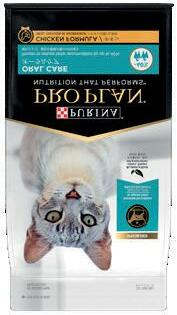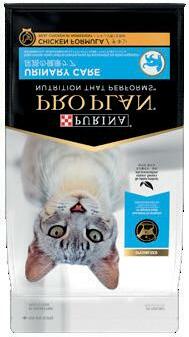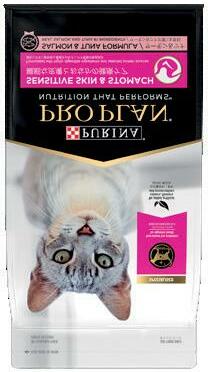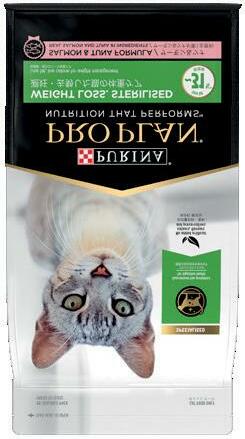














There are changes afoot in the pet industry. Just as we were about to send this magazine to print, we received word that five out of six Directors had resigned from their position on the Pet Industry Association of Australia (PIAA) Board, citing “irrevocable differences with one board member”.
The outgoing Directors, including President Barry Codling, Diana Scott, Todd Clarkson, Nathan Smith, and Candice Seckold, had proposed a change to PIAA’s constitution and Board structure, which was ultimately voted down at a recent Special General Meeting (SGM). Barry Codling’s opinion piece in this issue of Pet Industry News, which was written and submitted ahead of the SGM and can be found on page 46, outlines what the vision had been for the proposed new Board structure, which would have involved consideration of the directors’ experience, skills, attributes, and capabilities.
Anthony Ramsey, the sole remaining PIAA Director, who was opposed to the changes and rallied enough support to vote them down at the SGM, has vowed to rebuild the Board, and has told Pet Industry News that moving forward that “PIAA will also seek to actively engage and cooperate with likeminded organisations such as Australian Pet Care Association (APCA) and the Aquarium Industry Association of Australia (AIAA)”. We will provide updates on petnews.com.au as further updates arise.
Australia’s pet industry is thriving with almost 70 per cent of Australian households owning a companion animal, and this issue of Pet Industry News has a focus on the health and wellbeing of not only those pets, but on the vets who treat them. Caroline Zambrano investigates Australia’s veterinary shortage and mental health crisis and finds out what the industry is doing to help attract, retain, and care for veterinary staff. She also explores the pet technology revolution and all the products and services designed to help people achieve better health and wellbeing for their pets. Meanwhile, Claire Hibbit looks at the growing popularity of fishkeeping and best practice for retailers when it comes to education around aquarium management and fish husbandry.
We’ve also got articles from Bronwyn Orr, President, Australian Veterinary Association, Jared Patrick, President, AIAA, and Stephen Wilson, Category & Insights Manager, Strikeforce as well as insights from IRI on the growth of online shopping in the pet sector.
We spend five minutes getting to know Ben Dessen, Retail Manager, Kellyville Pets. And we see how iconic Brisbane pet store, Pet City, has celebrated its 65th anniversary.
We hope you enjoy reading!
Cheers, Deb Jackson Associate Publisher26 Veterinary crisis:
Attracting, retaining, and caring for veterinary staff
8 5 minutes with…
Ben Dessen, Retail Manager, Kellyville Pets
54 Media and the pet industry:
Dr Harry Cooper on how to grab the
PUBLISHED BY:
C&I Media Pty Ltd A division of The Intermedia Group 41 Bridge Road (PO Box 55) Glebe NSW 2037 Australia Tel: 02 9660 2113 Fax: 02 9660 4419
Media pty Td
Group Publisher & Commercial Director: Safa de Valois safa@c-store.com.au
Associate Publisher: Deborah Jackson d.jackson@c-store.com.au
Editorial Director: James Wells james@intermedia.com.au
Deputy Editor: Thomas Oakley-Newell tom@c-store.com.au
Editor-at-Large: Bob Croucher
Head of Sales & Strategy: Elena Sabag esabag@petnews.com.au
Senior Designer: Leanne Hogbin leanne@intermedia.com.au

Pre-press: Tony Willson tony@intermedia.com.au
Production Manager: Jacqui Cooper jacqui@intermedia.com.au
The Intermedia Group takes its Corporate and Social Responsibilities seriously and is committed to reducing its impact on the environment. We continuously strive to improve our environmental performance and to initiate additional CSR based projects and activities.
As part of our company policy we ensure that the products and services used in the manufacture of this magazine are sourced from environmentally responsible suppliers. This magazine has been printed on paper produced from sustainably sourced wood and pulp fibre and is accredited under PEFC chain of custody.

PEFC certified wood and paper products come from environmentally appropriate, socially beneficial and economically viable management of forests.
The wrapping used in the delivery process of this magazine is 100% recyclable.
This publication is published by C&I Media Pty Ltd (the “Publisher”). Materials in this publication have been created by a variety of different entities and, to the extent permitted by law, the Publisher accepts no liability for materials created by others. All materials should be considered protected by Australian and international intellectual property laws. Unless you are authorised by law or the copyright owner to do so, you may not copy any of the materials.
The mention of a product or service, person or company in this publication does not indicate the Publisher’s endorsement. The views expressed in this publication do not necessarily represent the opinion of the Publisher, its agents, company officers or employees. Any use of the information contained in this publication is at the sole risk of the person using that information. The user should make independent enquiries as to the accuracy of the information before relying on that information.
All express or implied terms, conditions, warranties, statements, assurances and representations in relation to the Publisher, its publications and its services are expressly excluded save for those conditions and warranties which must be implied under the laws of any State of Australia or the provisions of Division 2 of Part V of the Trade Practices Act 1974 and any statutory modification or re-enactment thereof. To the extent permitted by law, the Publisher will not be liable for any damages including special, exemplary, punitive or consequential damages (including but not limited to economic loss or loss of profit or revenue or loss of opportunity) or indirect loss or damage of any kind arising in contract, tort or otherwise, even if advised of the possibility of such loss of profits or damages. While we use our best endeavours to ensure accuracy of the materials we create, to the extent permitted by law, the Publisher excludes all liability for loss resulting from any inaccuracies or false or misleading statements that may appear in this publication.

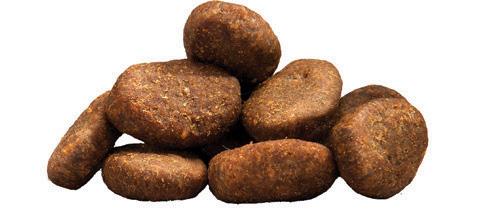


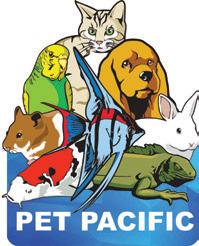
Dessen,
Manager,
Industry Spotlight
iconic
of
most up to date brand
latest news affecting
Pet technology
new technology
Veterinary crisis
making
in-depth look at the current veterinary shortage and mental health crisis.

Pet Industry Association of Australia

The PIAA moves to appoint a skills and merit-based Board.
Australian Veterinary Association
The AVA is working with community, government, and industry to help veterinarians.

Aquarium Industry Association of Australia
The AIAA fights for the addition of new fish species to the permitted import list.
The evolution of pet retail
principles on getting the most out of your pet retail store.
Pet ownership for children

Things to consider when acquiring a child’s first pet.

Media and the pet industry
Dr Harry Cooper looks at the media’s relationship with the pet industry.
Round table discussion:
Gut health in animals
Understanding how poor gut health can impact pets.
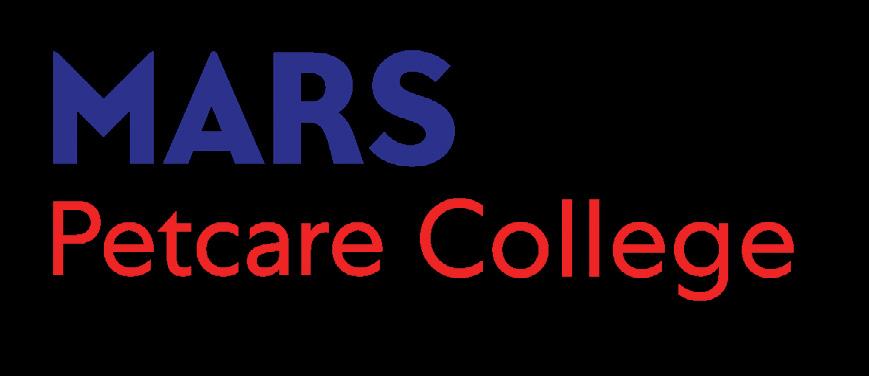






An infectious love for animals and education has led Ben Dessen on an exciting and rewarding career path.

SINCE BEING gifted a children’s python on his sixth birthday, Ben Dessen’s love for reptiles and animals has continued to grow, and now working as Retail Manager at Kellyville Pets, Dessen is able to impart his knowledge and passion to all those who visit.

“After my sixth birthday snake I was hooked. One snake became many, and pretty quickly we had reptiles and frogs and all sorts of creatures everywhere around the house. After a while, Mum and Dad said there were too many animals in the house so we built a big shed out the back.
“The shed is where I used to spend most of my time, breeding all sorts of snakes and lizards and amphibians and insects and that’s actually how it led to my job at Kellyville Pets when I was 15.”
Dessen was breeding stick insects and selling them to Kellyville, when one day he decided to bring his resume in and after an interview with Kellyville Pets’ owner John Grima, he walked out with a job half an hour later.

“When I came into a retail environment, I realised how much I enjoy sharing my passion with others and helping others to have the privilege of sharing their lives with so many amazing animals.”
Sixteen years later, that passion for animals has led Dessen to be managing the store alongside Richard Sheen, even if that’s not what he might have expected for himself at 30 years old.
“It really wasn’t a matter of if I would work with animals, I knew I would always work with animals, but I wasn’t exactly sure what that path would take. If I was in primary school or high school and you said, ‘When you’re 30 you’ll still be working in a pet store’, I’d say no, surely not.
“But you know, here I am, and I love it more than ever and I’m excited to continue driving the business forward and improving standards in the industry across the board.”
One of the changes that Dessen, Grima, and Kellyville Pets was instrumental in implementing, was the ability for pet stores to sell reptiles.
“Up until about 10 years ago, pet stores couldn’t sell reptiles. It really came down to our store and John working closely with the Government and the Pet Industry Association of Australia (PIAA) to get it across the line.
“Now there’s a few stores qualified to sell reptiles, and new stores that don’t currently sell reptiles can apply to get a special licence to be a commercial dealer and sell reptiles in their shop.”
Although Dessen warned that selling reptiles is not something a store should take lightly, given it is a very specialised area of animal care.
“If you don’t have educated staff and know the correct procedures and have the right setups in place, it’s ultimately going to fail or the animals are going to suffer. So that’s something that I would urge any shops considering taking on reptiles to think about very carefully.”
It’s not just Kellyville Pets that has been fortunate enough to reap the rewards of Dessen’s passion and knowledge, with his work allowing him to travel and participate in exciting projects.
“I’m very, very lucky to travel widely, not just through my work with Kellyville but I do quite a bit of work outside Kellyville with various conservation organisations and groups. I’ve spent collectively about six months living in the jungles of Borneo, working to help set up an orangutan orphanage in 2011/12.
“The orphanage that we established back then is now a fully thriving set up with orphaned babies coming through and being rehabilitated and raised and released into the wild. I’m very passionate about Southeast Asia and the work that we established there.”
Through the work in Borneo, Dessen then linked up with Bob Irwin, the late Steve Irwin’s father, and became a Director on the Bob Irwin Wildlife and Conservation foundation’s board helping to run fundraising for various conservation projects. But the moments Dessen cherishes most are the times he got to spend with Irwin in the bush doing what they both love.
“Every year in September all Bob wanted to do is get out into the bush, so we used to go out to a remote property in Cape York and spend a couple of weeks just catching crocs and snakes and doing wildlife surveys and just being out in the in the middle of nowhere together.”
“It really wasn’t a matter of if I would work with animals, I knew I would always work with animals, but I wasn’t exactly sure what that path would take.”Ben Dessen’s love of reptiles has been growing since his sixth birthday
Dessen sees Bob Irwin as the grandfather of conservation in Australia and said that after growing up watching Steve Irwin on TV, and then to be out in the bush years later learning from his father was a dream.
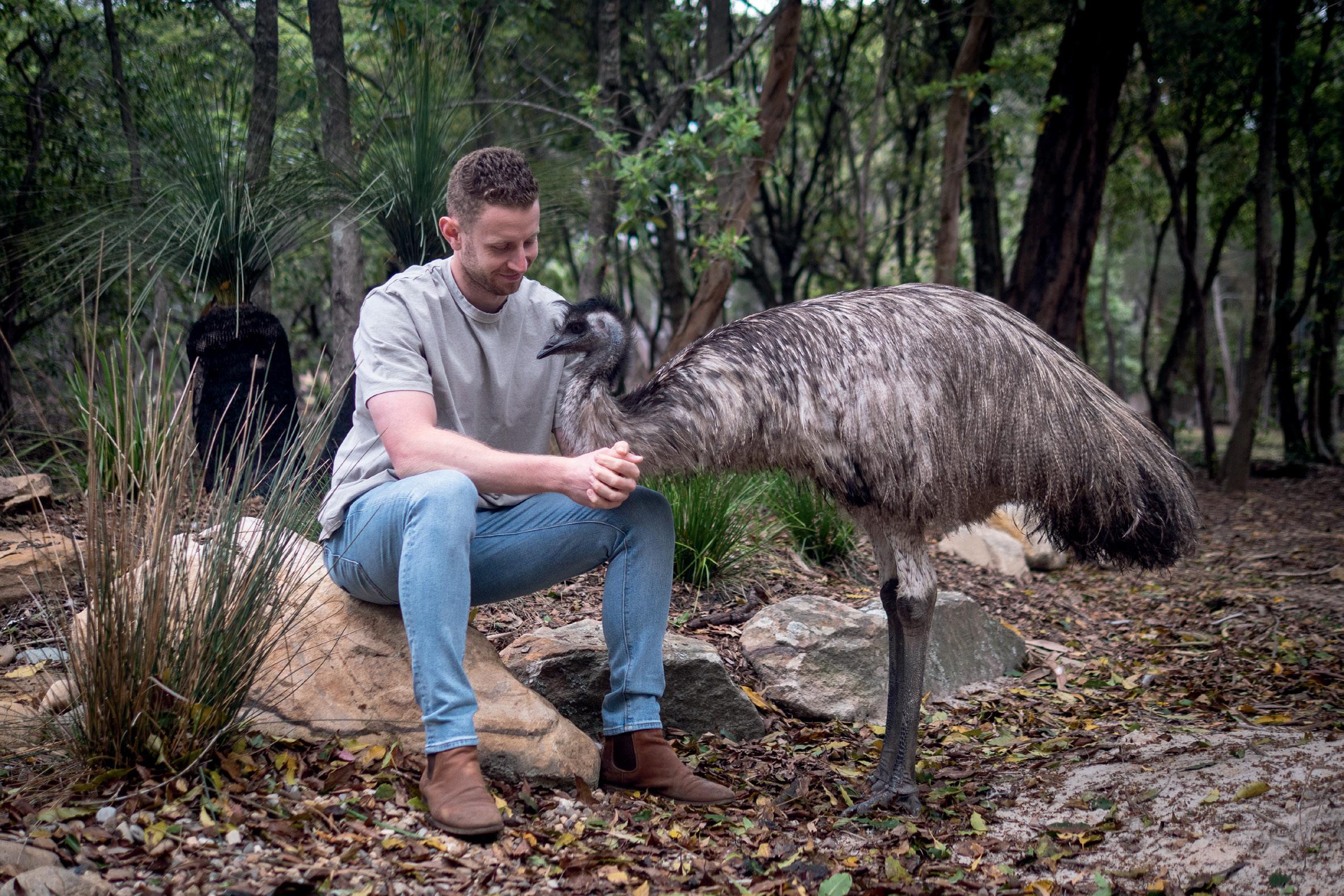
“To be able to spend time one on one with him in the bush hearing his decades of stories and his philosophies and things, I feel very privileged to be able to learn from someone of that calibre. I try and put the things I’ve learned from Bob into play every day with the things I do and the goals that I have moving forward.”
Educating people on how best to care for their pets is paramount to Dessen and Kellyville, and the launch of Kellyville Pets Pet School Online is a further testament to their desire to ensure potential, and current pet owners can provide the best possible life for their pet.
“We have always run education courses in person in our store. John was one of the first people to start doing that. I think we were the first pet store in Australia to start running educational in-person courses for looking after pets, and we’ve been doing it for two or three decades now.
“Obviously through Covid we had to stop the in-person courses, so we branched out to online. Initially, it was just me in a room doing the normal two-hour course to camera, but we thought we could so much better and there was a real opportunity to create something special.”
What resulted was a series of incredibly engaging cinematic masterclasses aimed at not only teaching
people the correct way to care for their animals but also entertaining them.
“When you watch it, it doesn’t feel like you’re watching a class or a school, it’s like an Attenborough documentary. There are drone shots of sweeping landscapes and we’re out in the rugged bush and trudging through the desert looking for lizards and all sorts of things. It’s like watching a documentary but you’re learning at the same time.”
Dessen hopes these masterclasses, which are $39.99 each for lifetime access, will allow Kellyville Pets to spread their knowledge to people who aren’t able to physically get to the store.
“Education is such an important thing for anyone looking to share their life with a pet and now with these masterclasses we can potentially educate people in every corner of the globe.”
Taking the masterclasses worldwide would be a fantastic achievement for Dessen and Kellyville, but Dessen believes none of this would have been possible if he wasn’t gifted that python on his sixth birthday.
“I think it all comes down to where I was when I was six years old. It was getting that pet snake and having an animal that was my responsibility to look after and nurture and teach my friends about.
“That’s what sent me on my path in life and now I’ve gone on to work with animals around the world such as the conservation work in Borneo and various other projects like the wildlife sanctuary that I run. You know, I don’t think I would have done all of that if I didn’t have that privilege and opportunity to keep a reptile as a pet.” n
“When I came into a retail environment, I realised how much I enjoy sharing my passion with others and helping others to have the privilege of sharing their lives with so many amazing animals.”Ben Dessen has been fortunate to be mentored by the late Bob Irwin Senior and Dr Harry Cooper





Iconic Brisbane pet store Pet City might be celebrating its 65th anniversary but it has no plans on slowing down.
FIRST OPENING its doors in 1957, this year marks the 65th anniversary of independent Brisbane pet store, Pet City. Founded by Evio Contenati and his brother-in-law, it was originally named Mt Gravatt Produce Agency and stocked farming basics such as hay, grains, and fertilisers, to cater to the predominantly rural area, but has since grown into one of Brisbane’s most iconic independent pet shops.
Pet Industry News sat down with Evio Contenati and Kim Peries, Owners of Pet City, to discuss how the business has grown and adapted over its long history.

Pet: What is the background of Pet City? Contenati and Peries: Pet City owner, Evio Contenati and his brother-inlaw first opened Pet City in 1957 as Mt Gravatt Produce Agency. In the

early 1970s, Mt Gravatt had many more families and pets in the area, so the name Pet City Mt Gravatt was adopted. By the 1980s we were a fully-fledged pet department store, one of the first in Australia, reflecting our dedication to supplying quality products for quality pets and their owners.
Fast-forward 65 years and Pet City is one of Brisbane’s longest standing independent pet shops, which has been locally owned since its inception. Pet City founder, Evio Contenati and his daughter, Kim Peries, are still very involved with the store.
Contenati and Peries: At Pet City we have more than 30 team members - all experts within their departments specialising in aquariums, birds and reptiles, small pets, as well as our online team. Our passionate team of animal lovers are second to none when it comes to their expertise around everything required to help you and your pets live their best lives.
Our customers are always impressed by our range of pet supplies. Catering for even the most unusual pets – we’re your one stop shop for all your pet supply needs.
Contenati and Peries: small feat, and the industry has changed a lot over that time.
early years was definitely one of our most significant changes as we adapted to the needs of locals.
through the economic and social upheaval. The foresight of our management team and development around our online store really helped us stay agile.
Pet City staff from past and present gathered to celebrate the 65th anniversary, including one team member who is celebrating 30 years at Pet City
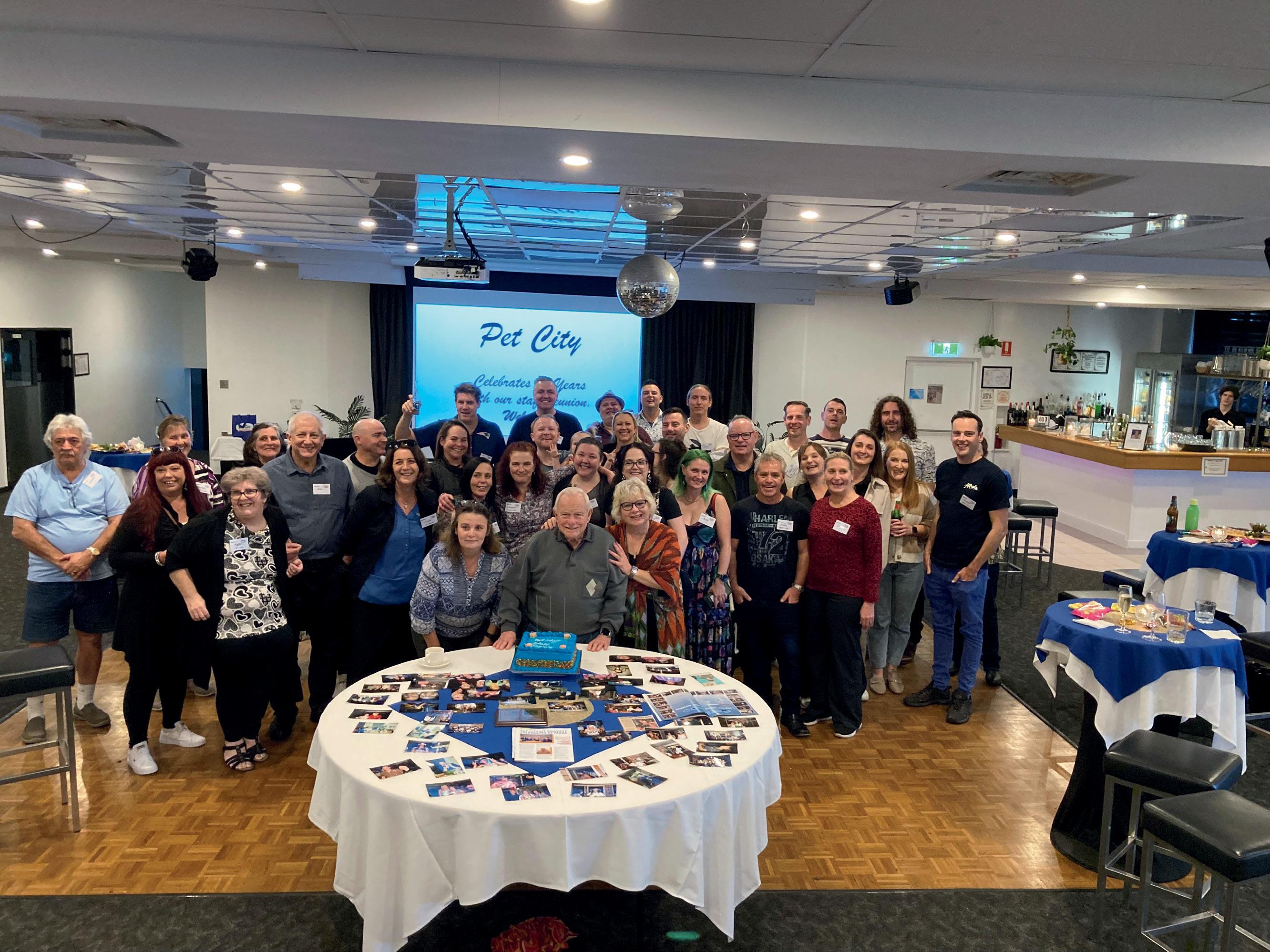
Contenati and Peries: There have been significant highlights in our development, including being able to supply clean, graded bird seed for aviculturists along the east coast of Australia. Pet City has been committed to providing education for pet owners and has staged many information sessions for the public to attend, with proceeds going to various charities. Among these was the first Marine Conference in Cairns as well as Reptecon.
One of the most delightful highlights in our 65 years has been the opportunity to have school and TAFE students visit the store for tours and attend education seminars. It has also been gratifying to have the support of so many of our local, state, and federal politicians who have conferred with us to gain the benefit of our expertise when seeking to create new legislation pertaining to the pet industry. Additionally, being the recipients of a number of pet industry awards, including the Pioneer and Kevin Panks Awards, has proved most gratifying.
Contenati and Peries: We might be 65, but we’re still young at heart. We celebrated with a big animal-themed party, of course. We had animal face painting, a sausage sizzle, the Wildlife Rangers brought some amazing wildlife along for pats and photos. We even had a visit from popular children’s TV characters – Bluey and Bingo. To celebrate 65 years, our major prize giveaway was a
“Our customers are always impressed by our range of pet supplies. Catering for even the most unusual pets – we’re your one stop shop for all your pet supply needs.”
Pet City Owner, Kim Peries was honoured to receive acknowledgement for 65 years in business from Lord Mayor of Brisbane Adrian Schrinner

65-inch TV. We were very happy to discover that the winner is a Pet City local who has been shopping with us for six years.
Contenati and Peries: To empathise with each customer, listen and assist them in providing a holistic approach to offering the best life they can to their companion animal, fur baby, best friend, or mate. Our customers’ pets mean the world to them, so they mean the world to us.
Contenati and Peries: Even at 65 years of age, we’re not too old to dream.
What remains very important is that we continue to invest in training our team to be experts in their field. We hope to continue with providing the best customer experience possible, assisting generations to come with their companion animals.
Contenati and Peries: In the past few years, we’ve seen the emergence of pet store chains who have threatened to push independent pet stores out of the market. Fortunately, our team’s expertise and our huge range of quality products has helped us maintain a loyal customer base. For us to reach 65 years shows that we have something very special.
There’s also an information overload out there about how we
“There’s always more to strive for when it comes to providing top tier customer service. Customer benefits, animal welfare, and sustainability are all areas we want to continue to excel in.”
should be looking after our pets. We hope to continue educating our customers on things like the importance animal enrichment and feeding a balanced diet with quality ingredients. At the end of the day, happy and healthy pets are our top priority, and we want to help every pet family achieve this.
Contenati and Peries: It’s no surprise that our team absolutely loves pet visits and helping customers find everything they need for their pets. A highlight for some of our long-standing team members is seeing generations of the same families who have been coming to Pet City for years.
Contenati and Peries: We’re always looking forward to staying ahead of industry trends. There’s always more to strive for when it comes to providing top tier customer service. Customer benefits, animal welfare, and sustainability are all areas we want to continue to excel in. n

For decades owners of muzzled dogs have experienced prejudice when out and about. However, amongst younger owners, the mood is shifting. The stereotypical label of “aggressive dogs” sporting a muzzle is a thing of the past. A new study by Company of Animals on behalf of Baskerville® (2022)* found 31% of the nation’s dog owners acknowledging their need for a muzzle during visits to the vet or a groomer. It is therefore hardly surprising that 61% of these muzzle purchasers cite “stressful situations” rather than “aggression or biting” as their reason for purchasing this training tool. With this insight, pet professionals can leverage their influencer status to normalize muzzle usage and pave the way for fighting the stigma around muzzles.


The Baskerville® study* found that 62% of muzzle users cited “comfort” as a requirement for their purchase decision while 54% acknowledged the ability to pant happily as being crucial to their choice.
Designed by experts for over 35 years, Baskerville® humane muzzles guarantee high standards of safety both for dog and owner, while allowing the best comfort possible for the dog to pant, drink and take treats.
Elected as the Best dog muzzle**, Baskerville® is recommended and used by behaviourists and vets around the world.

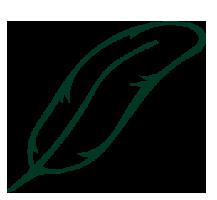

Despite fishkeeping’s ongoing popularity, there are currently no formal qualifications for aquarium management and fish husbandry.
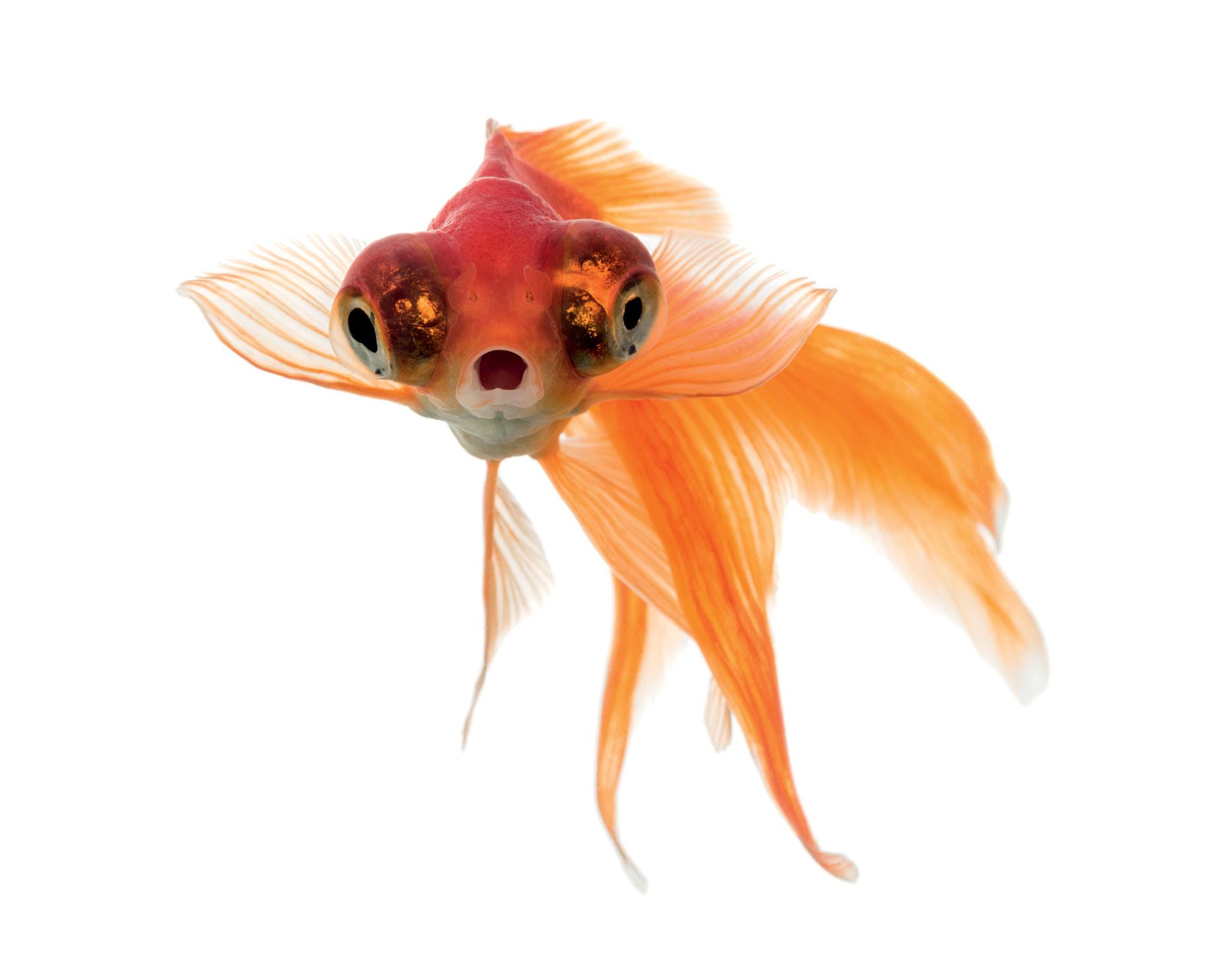 Words Claire Hibbit
Words Claire Hibbit
THE PANDEMIC has led to a boom in pet ownership across Australia. In fact, 69 per cent of Australian households now own a pet, up from 61 per cent only two years ago, according to Animal Medicines Australia’s Pets and the Pandemic study.
While dog and cat ownership has led the surge over the past two years, there has also been an increase in the number of households with pet fish, which has grown from 11 per cent to 13 per cent.
“Fishkeeping experienced a boom during the pandemic,” explains Jared Patrick, Managing Director of Premier Pet, and current President of the industry’s peak body, the Aquarium Industry Association of Australia (AIAA).
“People were not travelling as much and staying closer to home, so they had more spare time to spend on hobbies, such as aquatics. However, the challenge we are currently facing is keeping these new entrants captivated by our hobby while the world opens back up again.”
Like any animal, fish have a very specific set of requirements to ensure their health and wellbeing in a tank setting long term. Most retailers will have a checklist of the requirements for consumers setting up tanks at home for the first time.

This will include an adequately sized tank for the size and style of species being kept, as well as number of fish being housed, suitable lighting for viewing the fish or growing plants, appropriate décor, or ornaments to provide cover for the fish, a species-specific diet, as well as any water conditioning chemicals or test kits.
According to Ben Dessen, Retail Manager at Kellyville Pets, fish are more complex pets to keep due to the nature of the aquatic environment in which they live and rely on for their survival. If one element of their set up is not right, this will lead to a myriad of health complications and a negative experience for the customer as well as a poor welfare outcome for the fish.
Additionally, he says customers need to be educated about the nitrogen cycle and importance of cycling their tank before introducing any fish. This includes detailed customer education about water parameters and how to regularly test their water.
Just as important for retailers is in-store presentation.
“A professional, well-maintained store with clean tanks, healthy fish, clear signage and pricing, well merchandised products, and knowledgeable and friendly staff should be a minimum requirement for any store,” says Dessen.
According to Patrick, retailers should try to keep the set-up process as simple as possible so to not deter newcomers, while also providing a balance of enough information to ensure the aquatic life is adequately maintained.
Anthony Ramsey, Owner of Crystal Palace Aquarium and Founder of the AIAA, says it is essential retailers manage customers’ expectations and provide them with genuine advice and not just sell as much as they can upfront.
“Success leads to repeat business over many months as they stock their aquarium and then for years to come with associated consumables, such as food, water treatments, and replacement filter medias. Poor advice or greedy selling inevitably leads to failure, which ultimately leads to customers giving up on the hobby,” he says.
“The two most important pieces of advice for any new customer is to stock your aquarium slowly, over six to eight weeks, with four or five separate additions of fish. More important however is managing feeding and instilling the knowledge that less is more to ensure customers don’t crash their tank from excess and over feeding.”

Despite fishkeeping’s ongoing popularity, there are currently no formal qualifications for aquarium management and fish husbandry.
“For the most part, knowledge in the aquarium industry is gained from years of immersed experience and a lifelong passion of keeping all facets of ornamental fish varieties,” explains Ramsey.
However, he says there are many informal and online training modules offered by some suppliers and specialist aquatic vets. These training modules cater to both retailers and consumers and are predominately aimed around fish health (diagnosis and correct treatment), water chemistry, nutrition, and compatibility.
“There is definitely room for improvement, especially among larger big box retailers as they often see a high turnover of staff and their staff often won’t be dedicated aquatic specialists. This can sometimes lead to less-than-ideal advice being offered.”
Dessen says training varies significantly between retailers.
“It is up to an individual business to implement its own training and educational programs for its staff, to ensure they are confident and competent in all aspects of fishkeeping. As a result, staff knowledge and experience are not consistent and will vary store by store.”
He says it is important for staff to intricately know the fish species they keep and sell.
“Staff should be knowledgeable about the particular species or group of fish they are selling in their store. Issues can arise from poor customer education, which will ultimately lead to health complications with the fish and issues long term.
“It would be great to see an industry specific training qualification rolled out to the pet industry. This would help to raise standards overall and ensure that all staff working in pet stores have a minimum level of knowledge.”
Similarly, Patrick says education of the optimum husbandry for any companion animals, aquarium fish included, can always be better and will always be an issue.
“In saying that, the standard of knowledge available within many specialist
aquarium stores is very good. It is so important to have the basic care requirements covered in any pet or aquarium shop as we need as many newcomers as possible to be successful in aquatics. This is important for the maintenance and growth of the hobby and industry.”
The aquarium sector has not been immune from the challenges seen throughout the economy. Cost of freight, delays, and poor availability of freight as well as manufacturing/fish farming delays has seen significant increases in both costs and the consistent availability of both live fish and aquarium related products and equipment.
Strict government regulations on both the importing and quarantining of live fish and a limited list of species approved for live import are also huge challenges for the legitimate aquarium industry.
“While the vast majority comply and do the right thing, a lack of compliance in this space has seen a rapid growth of an underground aquarium industry, largely independent from the legitimate industry,” explains Ramsey.
“This black market side to the aquatics sector profits greatly from smuggled species, usually sold through online channels, that the mainstream industry is prohibited from trading in.”
One of the biggest issues currently facing the aquatics industry is the rising costs and complexities surrounding the importation of fish into Australia. Increased freight and logistics costs are seeing the prices of fish rise significantly, both at a wholesale and retail level.
“On a national and global scale one of the biggest challenges being faced now is the supply chain and logistics challenges,” says Patrick.
“From issues with the fish being delivered from rural areas in Indonesia, Malaysia, and Thailand into the capital cities
“It is so important to have the basic care requirements covered in any pet or aquarium shop as we need as many newcomers as possible to be successful in aquatics.”
– Jared Patrick, Managing Director, Premier Pet and President, AIAA
for export, to international airfreight being offloaded, to very expensive international airfreight (three to five times pre-Covid costs), and then all of the increasing local costs we’re experiencing. Then we see the delays in deliveries to pet and aquarium shops within Australia due to transport shortages and bottlenecks.”
A tightening of the legalities and requirements surrounding fish importation is also contributing to an increase in costs, according to Dessen.
“A number of leading fish wholesalers are focusing on increasing the number of ornamental fish they breed in Australia to combat the complexities of importation. This is also a favourable environmental outcome as it takes pressure off the wild harvest and collection of many fish species overseas.”
In addition to aquascaped tanks, other popular trends include nano-tanks and nano-fish, shrimp-only tanks, and also living reef marine tanks.
Technology has evolved to enhance the fishkeeping experience for both keepers and the fish they are so passionate about. Recent advancements in LED aquarium lighting have resulted in a wider variety of plants and corals being kept successfully in a captive setting.
Additionally, smart filtration systems and tanks are taking the hobby into the future, with devices capable of measuring temperatures and water parameters and feeding this data to a phone app.
“Not only is technology and the products we use improving, but our knowledge and understanding is constantly growing as well,” says Dessen.
So, what are the most popular fish species according to the experts?
According to Ramsey, perennial staples such as freshwater tropical species like; Tetras, livebearers and different catfish species, still remain the most popular by volume sold, while Siamese fighting fish remain a top beginner’s choice for small aquariums.
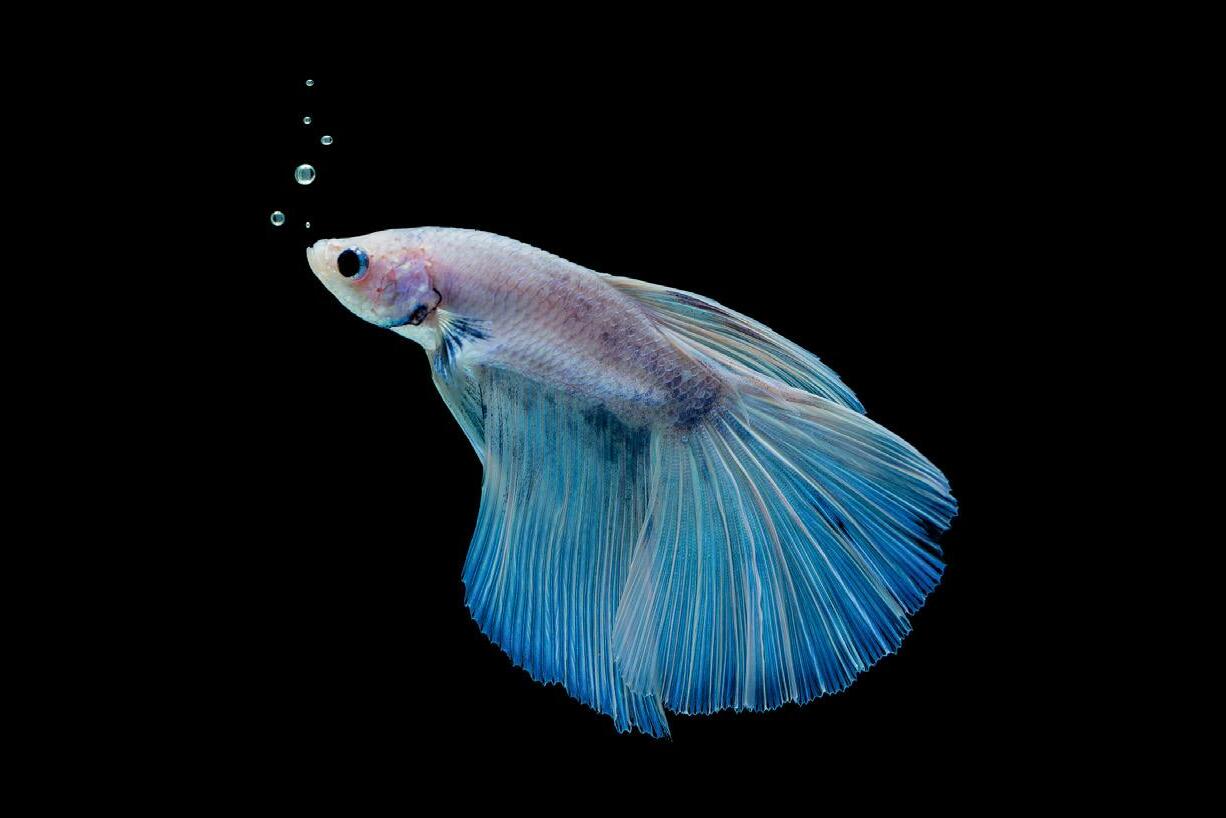
“The consumer trend towards smaller and smaller aquariums has seen a fall of popularity in larger Cichlid species and goldfish as they are better suited to larger aquariums. Instead, smaller all in one aquarium packages have seen a rapid rise
Currently, Australia has a strict aquarium fish list of allowable imports both fresh and marine. The AIAA has been working to add to the import list. The association currently has nine species being assessed for import under the Environment Protection and Biodiversity Conservation (EPBC) Act.
“This is a confusing, and onerous process whereby each fish is rigorously assessed by the Environment Department for suitability to be added to the import list,” explains Patrick.
“The draft submissions for each of the nine species has been out to public consultation and also, we have received some initial comments from the Environment Department for us to consider adding additional information to our reports. We expect to submit our final updated reports soon.”
The technology available in keeping marine and reef tanks has improved dramatically over the past decade and the subsequent success of keeping these animals has improved in parallel.
“At the entry level to the market, plug and play all-in-one aquarium packages continue to improve the quality of filtration and lighting they offer,” says Ramsey.

“At the top end of the market and particularly prevalent in the reefing scene is the rise of connected Wi-Fi or Bluetooth enabled devices. Many of these high-end brands now offer complete control, monitoring, and custom programmability direct from your smartphone.”
One notable trend has been the interest around ‘aquascaping’, which is the craft of arranging and creating aquatic environments with live plants, driftwood, rocks, and various substrates.
“A carefully aquascaped tank is equivalent to a living piece of art inside the home and can be a stunning feature,” says Dessen.
in the keeping of planted ‘nano’ aquariums, stocked with tiny tropical nano fish varieties and colourful ornamental shrimp.”
Dessen says the most popular ornamental fish species kept in Australia are goldfish varieties as well as common tropical species such as neon Tetras and bettas.
“These species are generally hardy and slightly more forgiving of any shortfalls regarding the husbandry of novice keepers,” he says.
“At Kellyville Pets we have not noticed a recent change and these entry level species have remained the most popular for many decades.” n
“It would be great to see an industry specific training qualification rolled out to the pet industry.” – Ben Dessen, Retail Manager, Kellyville Pets


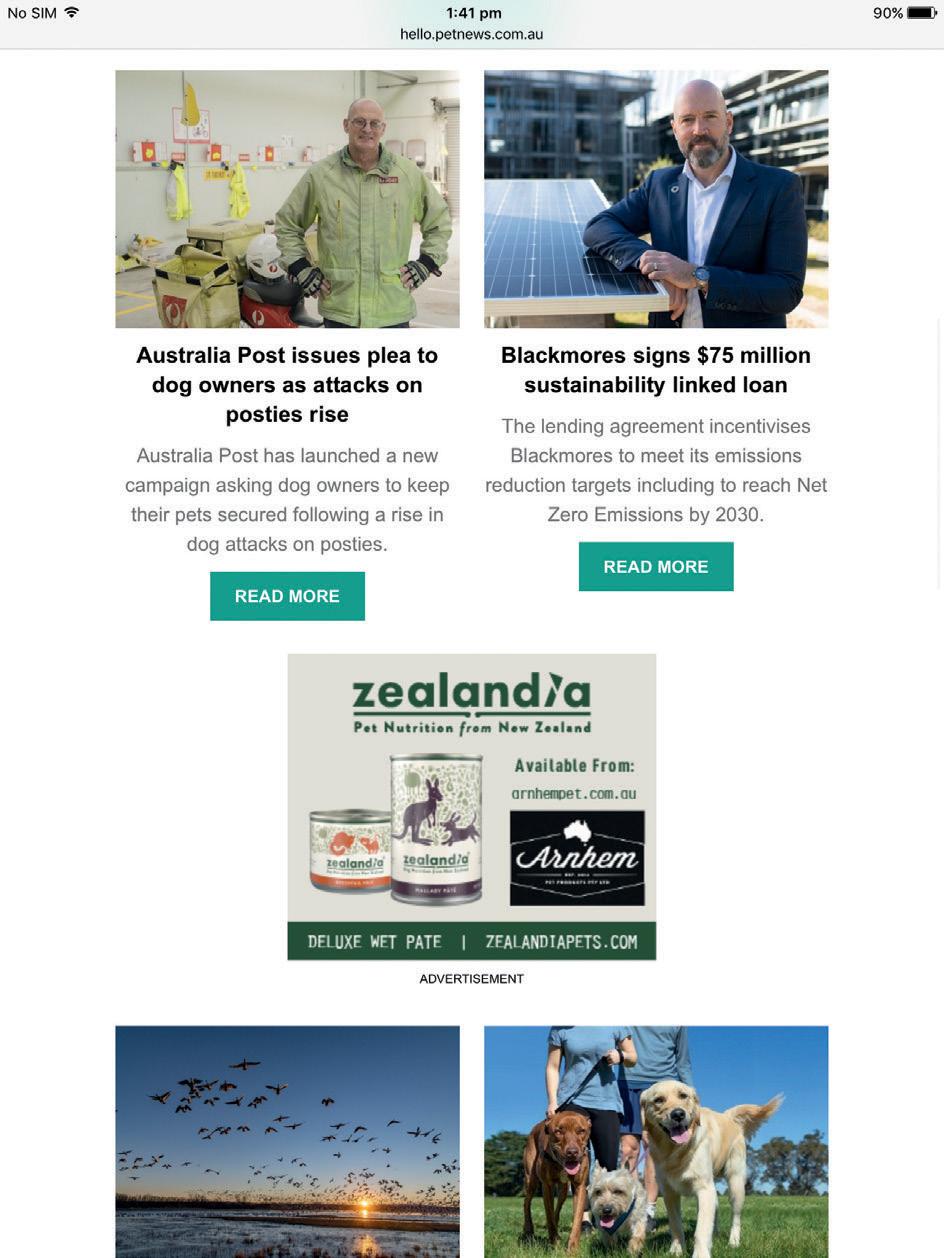
“Pets crave human touch and company so a daily belly rub, brush, walk, and games with your pets are a must, regardless of how much tech you have in your life.”
– Lara Shannon, Executive Producer and Host, Pooches at Play
THE COMBINATION of a growing and adored pet population and an increasingly tech-obsessed demographic of pet parents is driving an exciting industry inspired by today’s ‘smart manufacturing’ or what many are calling the Fourth Industrial Revolution or Industry 4.0.
It’s called Pet Tech – pet technology products and services designed to help people achieve better health and wellbeing for their pets – and it’s driving adoption, spending habits, and interest in the care and wellbeing of companion animals across the globe.
Global Market Insights reported the global pet tech market in 2021 to be worth US$5 billion and is set to grow at around 20 per cent (compound annual growth rate) from 2022 to 2028.
Last year’s survey by Michelson Found Animals Foundation revealed 56 per cent of American pet owners have special tech just for their pets, with pet health and nutrition apps being particularly popular.
“By embracing pet technology, pet parents can improve their pet’s wellbeing and make their life easier,” said Dr Teagan Lever, Veterinarian from Pet Circle, Australia’s largest online pet supplies company.
“There is now a larger range of smart pet products available in Australia, including technology to feed them, keep them entertained, track their health and location, keep them cosy, clean up after them and monitor them,

giving pet parents more flexibility in how they take care of their pet.”
Pet Circle has seen its sales for pet technology grow 53 per cent year on year from 2020 to 2021, with pet cameras and fountains growing 150 per cent thanks to the surge in pet ownership during the pandemic. Pet tech sales have also increased 47 per cent in March and April year on year with Australians taking advantage of New Year sales to modernise their homes for their pet.
“Australia is undoubtedly seeing the beginning of the pet technology revolution and the team at Pet Circle is expecting to grow its pet technology range substantially by the end of the year,” said Dr Lever.
It’s no surprise more and more companies are trying to fill the gap in the Australian market with smart technology-enabled pet gadgetry and provide a more complete ‘customer’ experience.
Jason Humphris, Founder of the popular Dog Lovers Show, said the show will be on the cutting edge of pet technology as it grows and develops, providing the leading promotional vehicle for pet tech nationally from next year.
Humphris shared exclusively with Pet Industry News that the Dog and Cat Lovers Show is collaborating with leading tech innovation company Nakatomi to provide an interactive testing platform for pet tech companies at the 2023 events.
“Australia is undoubtedly seeing the beginning of the pet technology revolution and the team at Pet Circle is expecting to grow its pet technology range substantially by the end of the year.”
“We will provide an opportunity to showcase the full range of pet tech products in front of a live audience of pet owners so they can gain immediate feedback. There will also be a dedicated Pet Tech Zone on the expo floor for local and international companies to sell and promote their products,” he said.
“Pet tech is already playing a major role in improving the health and wellbeing of our dogs and cats, with pet owners happy to invest heavily if it means enriching their lives and improving the quality of the relationships we share.”
The pet tech industry trends and advancements can be seen across pet food/products, services, health/medication, and technology.
Lara Shannon, certified dog trainer, behaviourist, and pet food nutritionist, as well as Executive Producer and host of Channel Ten’s Pooches at Play, is familiar with a range of pet tech, including DNA testing, which she did for her rescue dog Darcy.

“While this technology can help identify breed background, some advanced versions of the technology can also provide other health and disease risk summaries and more.”
Knowledge is power, after all. Breed information can be helpful for veterinarians in monitoring for potential health problems as pets age.
Shannon sees pet trackers and health monitors enabling owners and pet food manufacturers to create bespoke meals and calorie-controlled portions based on a pet’s exercise and other activity, “which may help to tackle a major health issue facing many Australian pets that are overweight and obese”.

New pet health company ilume is the first pet health program to bring together nutrition and tech, using a collar tracker and companion app to make intelligent decisions based on a pet’s real-time data. Ilume’s chef-prepared meals are specifically personalised through technology to enhance and extend the lives of dogs.
“By harnessing this insight through the use of smart technology and scientifically backed, restaurant-quality food, ilume helps to create a happier and healthier life for our beloved four-legged friends,” said ilume CEO and Cofounder Craig Silbery.
Smart and automatic feeders, including microchipcontrolled feeders, are a great way to ensure pets receive the right meal on time, as these gadgets allow you to
program a measured amount of food to be released at specific times, explained Dr Lever.
“They are perfect for pets on portion-controlled diets, pets that need regular feeding due to an underlying medical condition, such as diabetes, or for busy, multipet households,” she said. “Pet water fountains are also growing in popularity as running water may encourage dogs and cats to drink more, which is beneficial for their urinary tract and overall health.”
To cat owners’ delight, self-cleaning cat litter boxes are becoming more advanced with features like UV light for disinfection and activity and health tracking. For instance, cat owners can proactively monitor their pet’s health with Purina’s smart device The Petivity Smart Litterbox Monitor, which tracks behaviour and weight, and alerts you when changes might require your attention or a visit to the vet.
Dr Lever said smart toys, such as robotic balls and automatic lasers, have also become increasingly popular
– Dr Teagan Lever, Veterinarian, Pet CircleDr Teagan Lever, Pet Circle George Sofronidis, Co-founder and Managing Director of Orivet with Lara Shannon and her dog with a DNA test kit
“Aside from wearables, we will likely start to see more accessories with in-built sensors to help pet parents track more areas of their pet’s health, like beds that weigh pets and bowls that measure how much water your pet intakes – more information that would be useful to a vet.” – Dr Teagan Lever, Veterinarian, Pet Circle

with families looking to keep their pets entertained as they head back to work and school following the pandemic.
For instance, the PupPod Rocker toy uses lights, sounds and timing to create a mental stimulation puzzle for pets. When dogs interact with the PupPod Rocker at the correct time, they earn food rewards from a wirelessly connected feeder. Pet parents can stream video and control the game from anywhere using PupPod’s mobile app.
“Pet wearables can now monitor your pet’s daily activity by providing you with information about their exercise and sleep patterns. Some can also help you track their location in real-time and notify you when they wander too far from home,” said Dr Lever.
“Microchip pet doors are now controllable from your smartphone, allowing you to set curfews to prevent your pets from going outside at night or if there is bad weather, as well as restrict pets that can enter your home.”
Smart beds are a new category of pet tech, offering a cosy temperature-controlled place for pets to relax and sleep regardless of the weather. Pet cameras also allow people to interact with their pets from their smartphone and offer extra features including treat dispensing and automated lasers to be able to play with their pets remotely.
Pet cameras, such as the Furbo 360 Dog Camera, are being used by many pet parents to monitor their pets while they are not at home, which Shannon said can help identify underlying behaviour issues or promote desired behaviour by dispensing treats automatically.
“The more information we have about our pets and their behaviours when we aren’t around to observe them, the better it is to help devise an appropriate behaviour modification plan and strategies to assist them, particularly in relation to anxiety and stress,” said Shannon.
“I do warn owners though to be mindful that they are not causing more stress in their pets by talking to them through such devices, and to make sure any sudden or loud movements when dispensing food or treats aren’t causing more stress. They should be avoided in these instances.
“Pet tech in the form of TV program apps, such as Dog TV, can be used to both desensitise a dog to things like fireworks and thunderstorms, and provide relaxation and background noise that can assist dogs with mild separation anxiety.”
Technological advancements in the veterinary space are also changing the way we care for our pets. For instance, 24-hour vet telehealth services and vets on demand apps, like Pawssum, offer flexibility, personalisation, and convenience for both vets and consumers.

There are also collar-worn wearable devices that can be used to track our pet’s movements, including their activity, sleep, and sleep quality – quite useful during post-operative care and recovery.
Vetrax (owned by Hill’s Pet Nutrition) is worn on a dog’s collar and measures a number of health behaviours, such as shaking, scratching, walking and sleeping, and is designed to help pet owners and vets monitor numerous health conditions, from allergy flare-ups to obesity and diabetes. Simply download the app, attach the sensor, and let the communication begin.
GPS pet tracker collars, such as Whistle, are a device and app system that combines location-tracking and smart activity monitoring into alerting you and helping you locate a lost pet immediately and accurately.
“Aside from wearables, we will likely start to see more accessories with in-built sensors to help pet parents track more areas of their pet’s health, like beds that weigh pets and bowls that measure how much water your pet intakes – more information that would be useful to a vet,” said Dr Lever.
“We may also see more consumer tech brands, like Apple and Google, move into the pet category. We already have a dog tag from Studio Proper that allows you to secure an Apple AirTag to your dog or cat’s collar so you can track them, but we could see more specific pet products from these larger tech brands.”
While technology is very popular in training and interacting with cats and dogs, it is becoming increasingly popular for bird, small animal, and reptile owners, said Aylish McCarthy, Brand Development Coordinator at Vetafarm, Australia’s leading innovator in companion animal health and welfare.
“There are many electronic technologies such as interactive smart toys, but there are also so many nonelectronic things that are excellent for reptiles, birds and small animals like ferrets,” she said.
For instance, the Vetafarm team uses a Reptile One Ezistat to accurately control the temperature inside the terrarium of their office lizards – “an excellent tool to help reptile owners with varying levels of experience and make an absolutely integral part of reptile ownership much easier,” said McCarthy.
There’s a cool gadget for bird watchers, too. The Fussbric Smart Bird Feeder with Camera features a built-in powerful bird recognition system that connects to a phone app and allows you to monitor visiting birds and listen to them through the built-in microphone.
Pet matching apps help rescue pets Technology also plays a role in connecting with other pet owners and helping you find your ‘paw mate’, saving more animal lives. Based on the Tinder concept, pet matching apps (such as US-based social dog app PatchPets) match you with other like-minded pet owners and see if your dogs’ temperament matches, and then possibly lead to a park play date.
Other apps help you find a suitable pet for adoption, such as How I Met My Dog in the US and the Pedigree brand’s more recently launched Rescue Doodles, a program that uses artificial intelligence (AI) technology and a machine learning model to match a child’s creative portrait of their imaginary furry friend with a similar looking, adoptable dog nearby and is powered by Adopt-a-Pet.com, a Kinship company.
A pilot study by the University of Puerto Rico involving 55 dogs from the Humane Society of Silicon Valley and their adopters showed that providing dog quantimetric (intelligent insights) data to adopters using a smartphone application could yield reduced rates of re-relinquishment. Additionally, respondents indicated that they felt using the app helped them to better meet the activity needs of their dog and increased the bond between themselves and their newly adopted dog.
Brittany Bloomer, founder of Pound Paws charity, which provides a modern online approach to the overall rehoming process for pets available for adoption in pounds and rescue centres around Australia, said pet matching apps have transformed the way people adopt pets today.
“With over six billion active users on the internet, we are incredibly fortunate for the opportunity to use online platforms to assist rescue groups and pounds by showcasing their pets online to further increase the chance of adoption,” she said.
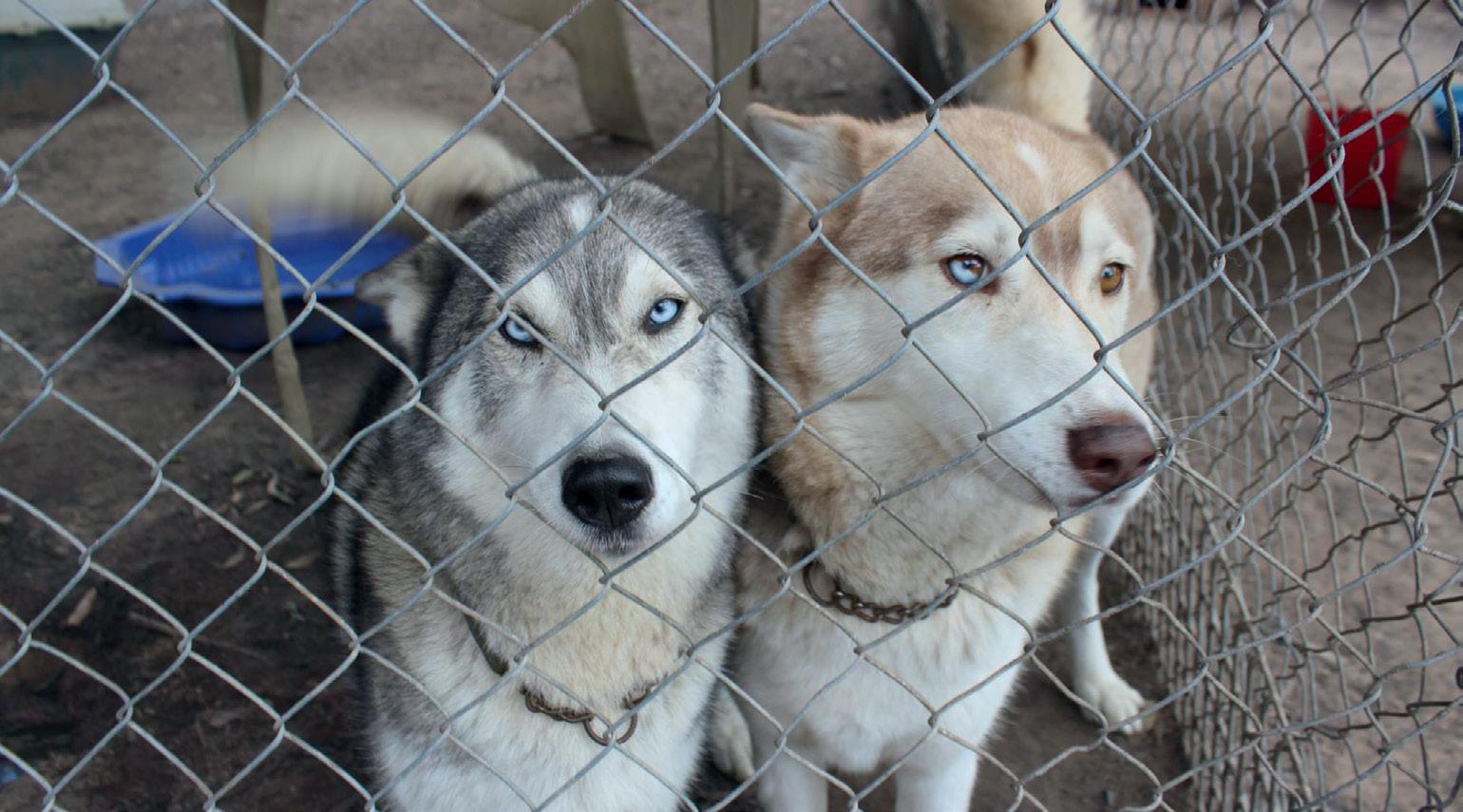
“Social media platforms like Facebook and Instagram have also been incredibly helpful to tap into large networks for free. We have witnessed firsthand the demand for online users searching for a rescue pet.”
Pound Paws launched the ‘Custom Pet Profile Match’ after the Covid pet adoption wave to help online users requesting help with finding a rescue pet. The process involves users completing an online form to explain what they are looking for in a pet and about their lifestyle. From there, Pound Paws researches and connects with local shelters to present the best pet profile matches they believed would match with them.
“This was a fun, personal way to further assist in the rehoming process. We received thousands of enquiries from around Australia since the Covid outbreak and have been fortunate to assist with many rehoming cases because of this,” said Bloomer.
Shannon said pet tech devices certainly provide many benefits, but we should be careful that we aren’t replacing time we would otherwise be spending with our pets with technology instead.
“At the end of the day, pet technology should be viewed as a way to assist in making our pet’s and our own lives easier and healthier,” she said.
“We should never replace spending quality time together cuddling on the couch, playing hands-on games of ball, tug of war and training, which is vital to develop good leadership and the bond with your pet. Pets crave human touch and company so a daily belly rub, brush, walk, and games with your pets are a must, regardless of how much tech you have in your life.” n
“There are many electronic technologies such as interactive smart toys, but there are also so many nonelectronic things that are excellent for reptiles, birds, and small animals like ferrets.” – Aylish McCarthy, Brand Development Coordinator, VetafarmRescue Dogs from Pound Paws
Pet Retail is a great industry to be in, but it can be challenging, and evolving faster than ever.
As an independent it can feel like you’re out there doing it all on your own, wondering if you’re really getting the best deals, as more and more competition crops up in your area.
That’s why we formed Indepet, a co-op unlike any other! As a group of independent pet store owners, we understand your business, because we’ve lived it, so we can really help your business thrive. We know we’re all stronger together.

• Boost your margins and buying power
• Streamline your operations and reduce admin
• Optimise your advertising with the latest digital marketing tactics
• Access retail, sales and marketing experts
• Future-proof your business, and get set for
• Join a network of like-minded business owners.
John Counihan Mt Barker Pet Care Centre
I’ve been in the pet industry for over 35 years. It’s more competitive now than ever and it’s changing even faster.
As a proud independent store owner, I believe it is important for independents to join together and support each other. Being part of a like-minded group of people gives me an opportunity to network and learn from others in the industry. Indepet is owned and directed by independent pet store owners like me who want to make our stores, and the industry, the best they can be. The Indepet network is an invaluable resource that we all need now, more than ever.






GONE ARE the days where resumes and applications would flood veterinary job openings. Like many veterinary clinics, Dr Lindsay Hay’s 37-year-old practice in Sydney has grown significantly through Covid and could easily employ another full-time vet, but that’s proving to be a problem.

“There are about 100 vacancies in Sydney alone and I have had an advert out there for four months with no bites yet,” said Dr Hay, who owns Baulkham Hills Veterinary Hospital.
The reason is there’s a veterinary shortage and mental health crisis and it’s putting added pressure on those left working in the industry where suicide rates are already high. Some studies show the incidence of suicide among veterinarians may be up to four times higher than the general population.
The veterinary shortage and mental health crisis have been going on for a long time and it is a global problem, not a result of the pandemic, although very much exacerbated by Covid, said Dr Hay.
In his 48th year as a vet, Dr Hay said veterinary suicide has been a challenge for 20 years, referring to his 2008 lecture notes to vet students on how to avoid veterinary burnout and find a work/life balance.
“A vet job is a hard one,” he said. “It’s a combination of issues including making hard decisions about life and death about animals, feeling like they don’t have enough support from the workplace, pressure from pet owners, and not earning a lot of money.”
What makes matters worse, pet ownership is at an all-time high, fuelled by the global pandemic. In fact, 69 per cent of Aussie households now own a companion animal, up from 61 per cent in 2019, according to the Pets and the Pandemic report by Animal Medicines Australia.
Dr Bronwyn Orr, President of the Australian Veterinary Association (AVA) said, “We have more pets than ever and higher than ever care requirements and client expectations for their pets. People are also investing a lot more in their pets’ health (with better care and nutrition), so we are seeing animals living longer.”
Corey Vella, Country Manager at Independent Vets of Australia (IVA), an independently owned buying and management group of independent veterinary practices, said the pandemic has fuelled a 30 per cent increase in clients and 50 per cent rise in workflow.
To put things into perspective – there are 13,993 registered veterinarians in the country, including part-time and government vets, according to the AVA. With 30.4 million
“The AVA is very much aware that there is no ‘magic bullet’ to solving the multifactorial issues of poor mental health within the profession. It will take time, effort, and money.”
– Dr Bronwyn Orr, President, AVA
pets (all species of companion animals), that equates to one vet to every 2,172 pets.
Dr Orr also works as an emergency veterinarian in Canberra and said the ratio during evenings/overnight is one vet to 40,000 pets – this doesn’t even include horses, farm animals and wildlife. Let that sink in for a moment.
She further explained that experienced vets are leaving the industry because the challenges are exceeding the rewards. Examples of this include the pressure clients put on them to care for their pet with unrealistic expectations and complaints of high costs.
Vet clinics across the country, particularly in regional areas, are having to close their doors after decades of serving their community.
“This means pet owners are facing one to two hours’ drive in an emergency and that can make a big difference, let alone the risk to Australia’s biosecurity when vets are not embedded in regional communities,” Dr Orr said.
Vella sees the pandemic as a ‘silver lining’, bringing the veterinary industry to a position where we must look at things with different lenses.
“Rightly or wrongly on how we got here, we need to change our approach in many levels,” he said. “We need to make sure more services and support systems are available for vets to access. Unfortunately, while there are some services out there for vets, they are not utilised by those who need it.”
Psychologist to the veterinary industry, Dr Nadine Hamilton founded the Love Your Pet Love Your Vet charity, aimed at increasing wellbeing in the veterinary industry. She did her PhD research into why poor mental health and suicide were prominent in the field and this year authored the Australian pet owner and veterinarian relationship research report funded by Royal Canin.
In a press release by the Australian Association of Psychologists (AAPi) supporting AVA’s call for veterinary health funding, Dr Hamilton said many vets feel ashamed about asking for help and often don’t want to see their doctor in the beginning to get a referral for a psychologist.
“If they could self-refer, it would streamline the process,” she said. “Vet nursing staff are also under pressure and often need counselling but for them it is often a budgetary issue that stops them from going.”
Raising the Medicare rebate for all psychologists to $150 could help those who needed mental healthcare to afford it, added AAPi Executive Director Tegan Carrison.


Dr Mark Lawrie, former CEO of the University Veterinary Teaching Hospital Sydney (2017-2022), explained that attracting and engaging students and new graduates, as well as developing and sustaining their future careers are of critical importance in addressing the shortage of vets.

He said the number of students wishing to pursue a career in veterinary science has not declined.
Attracting and engaging students and new graduates are of critical importance in addressing the shortage of vets
“Vets need to continually upskill and better delegate to leverage their time.” – Corey Vella, Country Manager, Independent Vets of Australia
working as a vet, and how they can add value and be appreciative of the career they have.” – Dr Mark Lawrie, former CEO of the University Veterinary Teaching Hospital Sydney
“Over the last decade there’s been a doubling of student applications to vet schools, in part because of the increased number of places. On the other hand, we are seeing a loss of graduated vets from the profession due to wellbeing and financial factors and a perceived fear of failure,” he said.
“There are about 800 vet graduates per year in Australasia. Covid has caused some reduction because some couldn’t get back from overseas and had to drop semesters. There will be a small reduction of graduates for a few years that will put further pressure on vet staff shortages.”
Unfortunately, university veterinary teaching hospitals are also struggling with staff shortages. Dr Lawrie expressed the need for vocationally-guided training options.
“Disseminated models (e.g. University of Nottingham) that outsource vet student training to non-university hospitals have to be considered, as does further involvement of corporate models. Time will tell how successful these are, but there is a sense that the traditional clinical training formats will struggle to survive,” he said.
“One aspect of veterinary clinical training that has played a prominent role is the part-time work that students do as staff at veterinary clinics and hospitals as they progress through the course. This should be looked at as a strategic opportunity.”
In the meantime, Dr Lawrie urged the veterinary industry to take a more positive approach in raising awareness of mental health and wellbeing of vets.
He said there are great resources flowing through from the AVA and various parts of the profession, plus a lot of focus at conferences about wellness and more broadly about coping with the modern vet world.
“Making the message too negative can have a flow on negative effect on students,” said Dr Lawrie. “Feedback from
some students shows they hear enough of the bad things and want to hear the positives about working as a vet, and how they can add value and be appreciative of the career they have.”
Furthermore, “having different careers across the vet industry is just a part of vet life, and in the modern world it’s more likely to happen. We should rejoice in that and not get too concerned about the loss of vets from one sector to another,” he added.
Dr Emma Davis of VeterinaryCareers.com.au works with veterinarians and businesses to increase profitability and keep mental health and wellbeing at the forefront. She shared her negative experience entering the veterinary workforce in 2001, saying she had “little support from my employers during the first few years of clinical practice. I feel now that I could have advocated for myself better at the time”.
Now, Dr Davis coaches people on how to advocate for themselves, prioritise looking after themselves and negotiate within their workplace.
“Many new graduates are intimidated by the profession and feel like an outsider as they start their career,” she said. “We set unrealistic expectations – often promoted in vet schools – and then push ourselves excruciatingly hard in the first five years because we feel we are playing catch-up to make our mark and fit into the profession.”
New graduates become like a “unicorn vet”, not knowing how to say no to anything their boss asks them to do, and sometimes working day and night with little sleep, she said.
“Working harder, taking those extra nights on call, it was like a rite of passage. It’s very competitive and not sustainable,” she added.
Understanding how difficult and intense it is to run a veterinary business, Dr Davis said some employers see all the hard work they put into their career and apply that expectation to young vets. But it doesn’t have to be that way.
“The future of vet business is to have a flexible workplace with vets working three to four days a week and on their area of interest, as currently reflected in physiotherapy and the medical professions,” she said.
In the AVA’s 2021 workforce survey of data on the current profile of the veterinary profession and anticipated future trends and challenges, 67.7 per cent of respondents said they believed in five years’ time there will be ‘more part time positions’ and 32.87 per cent said they anticipated ‘more remote working/flexible hours/home-based roles’.
“With the increased demand for veterinary services, there is an opportunity to create different business models to meet that need as opposed to the traditional practice model,” said Dr Davis.

There is also a continuing global rise in locum veterinarians where people are choosing where they work. It’s about keeping the control and managing work/life balance, working three days at one practice and a few days at another, she added.
“Workplaces in Australia have not yet fully adapted to how they use their ‘people resource’. Businesses need to step into rostering and focus on their team members’ strengths and what they can offer; for example, breaking that unicorn role into parts – say ‘a consulting school hours vet, a surgical vet, an
evening shift vet’, and letting several people fill the roles. This will help build sustainable relationships,” explained Dr Davis.
“Vets need to learn to have advocacy conversations and put what they need forward to have long term relationships with businesses. By meeting in the middle and working together to find new ways of interacting, we can then also attract retired vets.”
Dr Davis’ advice for new graduates is to work in a practice with a proper internal support system, where they can shadow more experienced vets and be given a gradual increase in responsibility.
“A veterinary career is effectively a professional running their own business,” she explained. “They say businesses can’t outgrow the owner, so I coach people on how to grow themselves in order to grow their business and take responsibility for their happiness. Whether a vet chooses to work somewhere or run their own shop, they need to know how to use their time, change the way they do things, advocate for themselves, and have good boundaries.”
Vella said one of the biggest issues IVA member practices have reported is simply not having time.
“The answer lies in driving efficiency in the workplace,” he said. “You can still give excellent quality service but do it in a shorter space of time so you can spread yourself across. Vets need to continually upskill and better delegate to leverage their time.”
Vets can also use technology to communicate with clients more efficiently and effectively and facilitate the smooth running of practice operations.
“Technology is changing dramatically, and more opportunities are now available to vet practices,” said Vella. “Vets need to find automation that drive efficiency by default; for instance, using apps for bookings. It’s not one thing that fixes everything but it will be a multitude of things to give you great support in business and ultimately give you time back.”
The vet industry is also gaining momentum in upskilling nurses and giving them extended roles, although many practices have not utilised this, explained Vella. Benefits of upskilling nurses include increased business profitability and client bonding to clinic, higher staff satisfaction and retention and of course, increased time availability of veterinarians.
Industry partnerships also greatly benefit veterinarians. For instance, “out of all the webinars IVA offers, the partnersponsored mental health webinars and training and support sessions have the highest registrations by far of any other topic they’ve ever run, and it’s constantly the same,” said Vella.
“A lot of practices are on the work treadmill. Vets don’t have time or are too apprehensive to get help when it’s available to them. They need to be encouraged to ask for help before the situation gets to a point where it’s difficult to recover.”
While not immune from staff problems, Dr Hay’s practice is in the very unusual position of not losing any team members in the past few years. With currently 15 staff, including six vets, the clinic is open every day seeing companion animals including exotics and wildlife.

“Our staff is stable, and the vets have been here by and large for decades. Our nurses similarly tend to stay for years as well, and we haven’t had to deal with burnout and mental health issues as a significant problem,” he said.
Dr Hall’s observation has been that practices that chose to separate into smaller teams in 2020 put the vets and particularly nurses at great risk of overwork/burnout.
“We chose not to do that as I felt the risks were too great and I think that helped a lot,” he said. “We also didn’t lock clients out of the practice to conduct ‘curbside’ consults or send nurses out for the same reason.”
Lucky, they had no Covid in the practice either.
“While it isn’t all about money, I have raised pay rates to
“With the increased demand for veterinary services, there is an opportunity to create different business models to meet that need as opposed to the traditional practice model.” – Dr Emma Davis of VeterinaryCareers.com.au
reflect how hard everyone is working. We also have to check in with everyone and make sure they are ok and still have their breaks. We have to say, ‘thank you’ both literally and by actions, such as treats and favours and the like.”
During Covid restrictions, two nurses built a market garden at the practice as a productive and enjoyable activity out of the home.
“We try to lead by example and encourage healthy lifestyle choices and also have fun,” said Dr Hay.
The AVA’s workforce survey and Veterinary Wellness Strategy Report have led to the recent launch of THRIVE, a veterinary wellness initiative that aims to support vets and their staff to lead satisfying, sustainable and healthy careers.

THRIVE’s initial planned activities include among other plans a formation of a Wellness Steering Committee with a call for volunteers in August and a Wellness Round Table with key stakeholders planned for October 2022 to help inform next steps.
“The AVA is very much aware that there is no ‘magic bullet’ to solving the multifactorial issues of poor mental health within the profession. It will take time, effort, and money,” said Dr Orr.
“We do think there’s been an undervaluing of the vet profession by the government. Vets manage biosecurity of the livestock industry, making sure the food we eat is safe, including the animals raised for the food being kept disease free.”
Dr Orr referred to the UK government’s 2022 launch of its Animal Health and Welfare Pathway to support farm animal health and welfare, paying for a vet to visit every commercial farm in the country once a year.
“For every farmer, that means their biosecurity plans are in place,” she said.
Veterinarians are not just the backbone of the pet health economy, they also play a crucial role in wildlife rehabilitation and conservation, not to mention responding to animal emergencies like in the deadly bushfires and floods. Exotic diseases are also picked up by veterinarians and we know how crucial this is to the global human health and economy.
Also, emergency animal diseases are a significant threat to animal industries and vets are key to Australia’s surveillance capacity, said Dr Orr. The risks will continue to increase as climate change impacts distribution of a variety of diseases.
The AVA is calling on the Australian Government to invest $3 million over five years to help the association progress mental health initiatives that will improve the sustainability of the profession.
“We want to make sure vets are in the right place at the right time. For local communities to have access to a vet when they need them,” said Dr Orr.
Dr Hamilton said she was disappointed by the Government’s disregard of the veterinary profession. In the AAPi press release, she said a number of submissions for grant funding for vet mental health, but all had been rejected, including a pre-budget submission by AAPi last year.
“I feel the government is not seeing the desperate need in this profession. The funding we applied for would have gone towards counselling, wellbeing workshops and educational resources,” she said.
As more people welcome pets into their family and rely on them for companionship and comfort, we need to provide our veterinarians much needed support and services to ensure they stay in the profession they love. It’s only through our collective efforts that we can create a paradigm shift for the veterinary profession. n

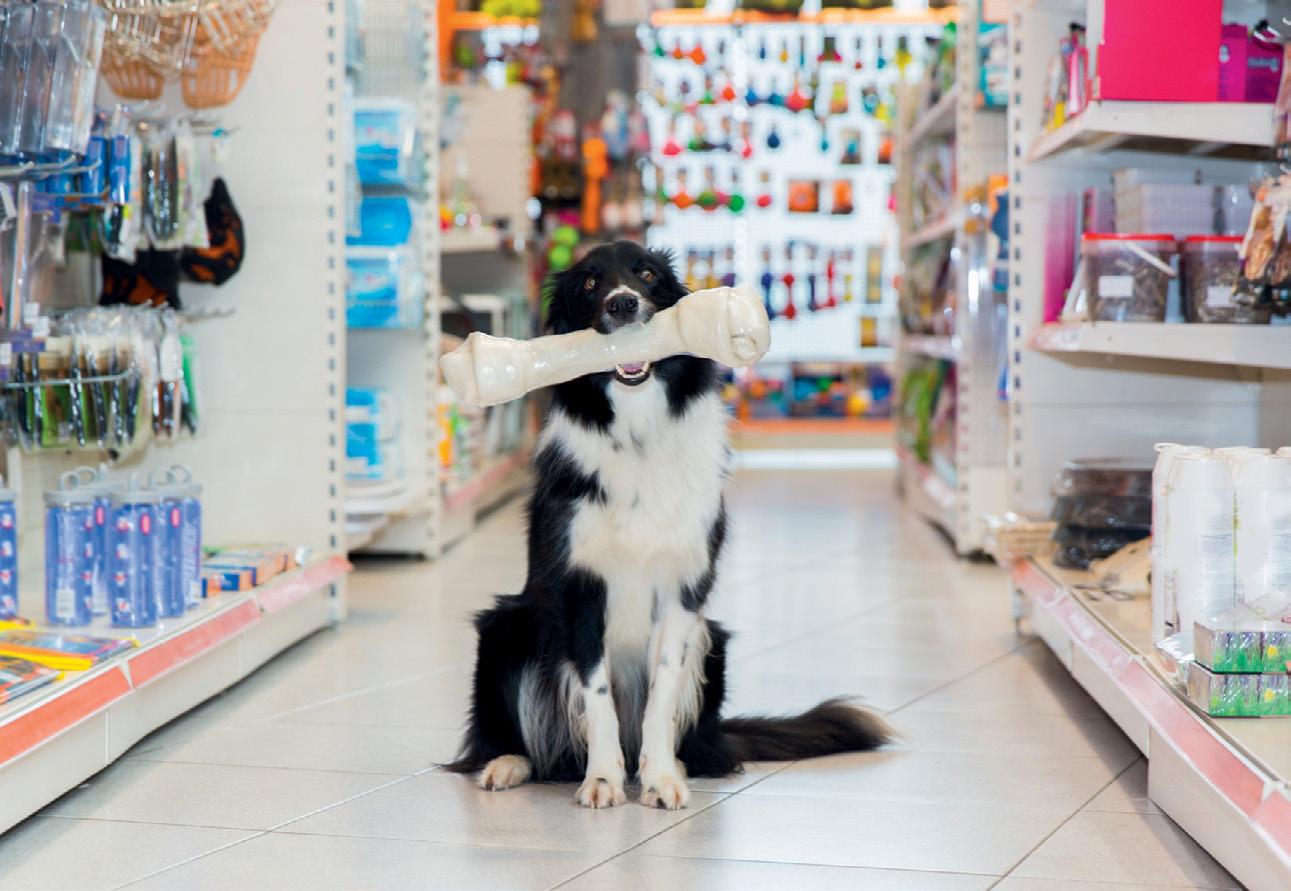
The Paws Room has brought together an appreciation for design with a love of dogs to create a considered collection of architecturally inspired pet furniture.
Underpinned by a belief that dog and human decor can be seamlessly integrated, The Paws Room’s furniture aspires to enhance feelings of connection and create a sense of belonging for all the family.

Balancing the significant space a dog crate occupies in the home, with the sanctuary and training support it provides for dogs, The Paws Room founder, Eliza Kennedy, sought a more attractive and durable alternative to the standard black wire crates available.

Kennedy said she was influenced by a dog behaviourist who advocates crate training for calmer, happier dogs.
“I wanted a crate that looked like it belonged in my living room and could be equally used as a table or bench,” she explained. “The goal was an easily assembled, stylish crate solution that brought harmony to home and hound.”


The Ultimate Pet Handbook is a new book by Ben Dessen created to help young people show compassion and kindness towards animals.
Dessen, who works as Retail Manager at one of Australia’s leading independent pet retailers Kellyville Pets, said he frequently met young people who have a desire to share their lives with pets, however they didn’t always know which pet was best for them or where to start, and he wrote the book for them.
“When I set out on this journey, I had a vision of writing the book that I wish I had as a young animal lover growing up. A book that would sit on my bedside table, that I could read every night before going to sleep. A book with pages that would become worn after being read for the 10th time. A book that would have handwritten notes scribbled throughout, about which pet I wanted to share my life with next and how I was going to give that animal the very best life,” explained Dessen.
Dessen received the support of two of his idols, Dr Harry Cooper and Bob Irwin (Senior), in the creation of the book, something he says he’s extremely fortunate of.
“Growing up, Dr Harry Cooper was one of my greatest sources
With a focus on local design and production, sustainable materials, and a minimalist aesthetic, she partnered with industrial designers Charles Wentworth and Carl Behrendorff. Together they have created Teddy, the stand-alone crate, Coco the couch companion and Jack, the cladding solution for those wishing to transform an existing crate into a stylish and multi-purpose piece.
“We are lucky enough to live in an Arcke designed house and love the architect’s signature use of birch plywood. It seemed the perfect material to blend a stylish home for our dogs with our home. We use a premium birch plywood with a clear laminate for easy cleaning.”
Having experienced the frustration of dogchewed timber furniture in the past, Kennedy worked with the designers to protect Teddy’s plywood fins and intended visibility with the use of perspex sliders and lockable doors. A new design is also coming that incorporates powder-coated metal rods with the birch plywood top.
“We can’t wait to introduce Franki. Our aim is to be Australia’s go-to provider for dog crates and furniture that delights,” said Kennedy. For more information visit thepawsroom.com.au
of inspiration and I am deeply humbled by his generous words in the foreword of The Ultimate Pet Handbook.
“The book also features an empowering message to young people from Bob Irwin, the father of Steve Irwin, who has taught me so much over the years.”
Dessen hopes that the book will inspire a new generation of animal lovers to be responsible for ‘pet parents’ and enjoy the privilege of sharing their lives with pets.
“The Ultimate Pet Handbook features over 30 individual ‘Pet Profiles’ covering all pet categories. Each ‘Pet Profile’ includes detailed husbandry information, pet tips and fun facts. Chapters in the book also cover topics such as ‘Planning for a pet’, ‘Choosing the right pet’, ‘Making a budget’ and ‘Where to find a pet’. There are templates allowing children to create their own ‘Pet Proposal’ and budget, to pitch to the adults in their lives.
“The book directs children to their local shelter or reputable pet store to find their perfect pet as well as purchase all the necessary equipment and supplies.”
The Ultimate Pet Handbook will be released in bookstores and online in late September 2022. For retailers looking to stock the book in their store, they can contact Robert Saba at New Holland Publishers at robert@newholland.com.au.

With more than six million units sold worldwide, the ‘life saving’ Pet Corrector has made its way to the Australian market.
Designed by leading animal psychologist, Dr Roger Mugford, this effective and humane home training aid has transformed the lives of millions of dog owners around the world.
Pet Corrector is a quick and simple training tool designed to distract dogs from unwanted behaviours such as barking, jumping up, place avoidance or stealing food, it can also double as a protection device to help owners interrupt dog attacks and signs of aggression before serious injury is inflicted.






All dogs have their good and bad days, but with Pet Corrector, you can get back to what really matters, enjoying life with your pet.
As an original sound-based training aid, this unique, patented product is inspired by nature and the ‘hiss’ sound emitted by snakes, insects, and birds to warn predators. By mimicking this sound, Pet Corrector has proven to consistently command your pet’s
attention, stop what they are doing, and enable the owner to positively reinforce an alternative behaviour that is more desirable.
Dr Roger Mugford said that for more than 40 years Company of Animals has been dedicated to giving dogs the best possible quality of life, so owners and canines can enjoy life together to the full.
“For many, happiness is compromised by new, disruptive, or even dangerous behaviours. Like us, all dogs have their good and bad days and life moulds our behaviour through our experiences of events, which can be rewarding or punishing. We invented Pet Corrector to help dog owners all over the globe to get back to the good stuff – enjoying life with their pet,” says Dr Mugford.
Pet Corrector has received worldwide recognition for more than 20 years and has received more than 20,000 positive consumer reviews, including “It’s a miracle in a bottle”, “Works immediately”, “Superb results”, and “Life Saver”. For enquiries and pre-orders email ordersau@wearecoa.com.


Designed by leading animal psychologist, Dr Roger Mugford, this effective and humane home training aid is trusted by millions of happy dog owners around the world.
enquiries and pre-orders
Home training made easy
Taking the USA and Europe by storm, Nothin’ to Hide is a traditional rawhide alternative that pet parents can rest assured knowing it will provide an exceptionally tasty, long-lasting chewing experience, while also readily breaking down in their dog’s stomach.
Petco, one of the largest pet supply companies in the US, removed traditional rawhide options from store shelves last year in the company’s latest step to ensure it’s providing better solutions for pets.
As a result, the company has removed all 32 traditional rawhide products from store shelves in favour of highly digestible rawhide alternatives, made with perforations to make them easier to digest.
Stuart McAskill, Senior Brand Manager at Masterpet, said that what most people don’t know is that traditional rawhide is a by-product of the leather industry.
“After soaking in harsh chemicals and preservatives it becomes a highly processed chew that’s extremely difficult to digest, through our research we have found digestibility becoming one of the most important features in dog treats that pet owners are seeking.”

This is how Nothin’ to Hide became the premium collagen-based chew you can trust. Nothin’ to Hide made by Fieldcrest Farms, comes in a variety of shapes and sizes as well as an assortment of flavours suitable for all breeds in all life stages. Using the highest quality, all natural, limited ingredients so you can rest assured you’re giving your pups the very best.

The collagen-based chews begin as a very fine powder, which is hydrated, shaped and oven baked. A delicious protein gravy
(beef, chicken, or peanut butter) is hand coated to each chew to ensure maximum taste enjoyment. The process utilises collagen and other ingredients, produced in human-grade collagen production facilities.
With pet owners spending significantly more time at home with their pets through the Covid pandemic, busy bones and long-lasting chews that keep pets busy and provide much-needed mental stimulation have become more in demand, with related product sales rising more than 10 per cent last year compared to 2019.
Australian pet retailers need to be on the front foot with innovation, with pet owners trusting the credibility from these specialised stores and Nothin’ to Hide provides the next break in innovation in the pet industry.
Matt Freeman, Training and Education Manager ANZ at Masterpet, said that not all rawhide treats are equal.
“Cheaper, inferior rawhide treats are imported and sold in Australia. Many of them are produced using chemicals, glues, and artificial colours to create a product that appeals to pet parents. These treats can often break off in large pieces and may lead to gastro-intestinal blockages.
“There are six layers in beef hide. The outer two layers are separated and used for the fashion industry (leather boots and wallets etc.) The middle layers are separated and used in the production of traditional rawhide products. The deepest two layers are used to make hydrolysed collagen.” To get onboard with the next evolution in dog treats, Nothin’ to Hide is now available for sale now and distributed by Masterpet Australia.


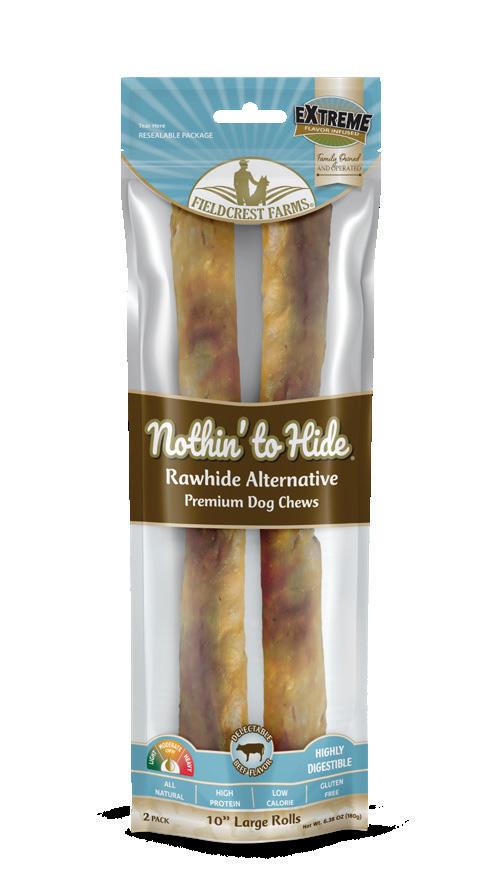









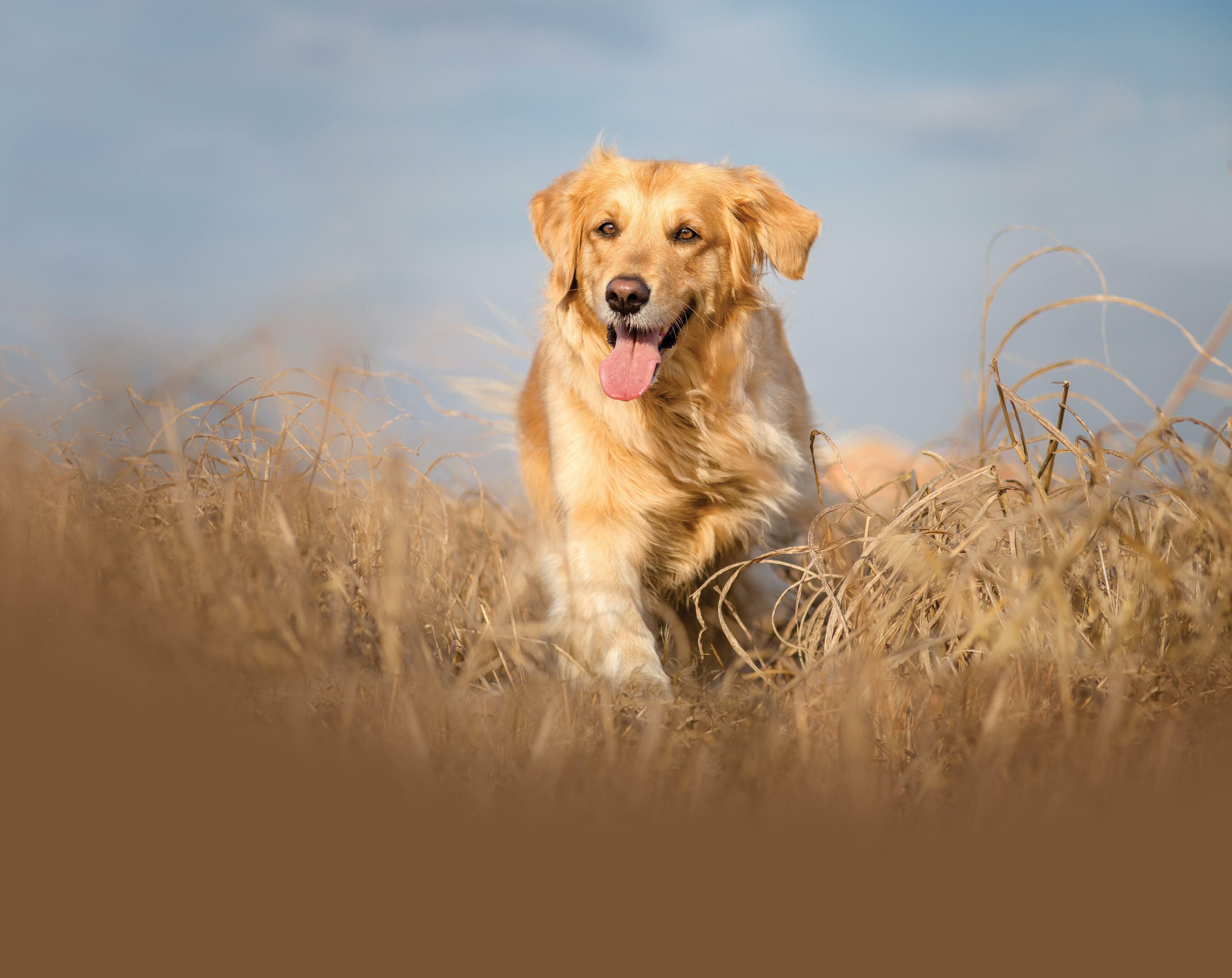


Our collagen-based chews begin as a very fine powder, which is hydrated, shaped and oven baked. We then apply our beef and chicken coatings for maximum flavor and palatability.
* Traditional Rawhide is perceived by some pet parents to be a choking risk and issue for their pet’s digestion.


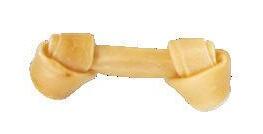

Ultimately though, pet’s enjoy the taste and consumption experience of Rawhide
Rawhide alternative is a safer alternative to Traditional Rawhide. It is often vegan or vegetarian – free from any animal products

Although perhaps safer for the pet, RawhideFree lacks the real meat taste and chew experience of traditional Rawhide therefore not as palatable
Nothin’ to Hide products are still made from animal products although processed in a unique way to ensure the treat is safe for the pet to digest
Nothin’ to Hide is basted with yummy “real” flavours making our treats both safe and palatable
Find out how they are made








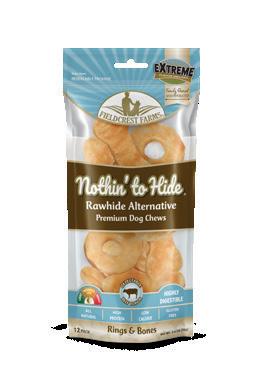



Trouble & Trix is no trouble at all Australia’s cat population has exploded in the past year, with an additional 1.5 million cats adopted into new homes during Covid.
According to the Pets in the Pandemic Report, most of these new owners came from those living in apartments and skewed towards a younger demographic.
With the now 4.9 million cats in Australia, these pets are spending more time indoors and owners are preparing their homes for this important member of the family.
The phenomenal growth and demand in litter has been driven by this booming indoor cat population, and it’s no surprise that a recent study found that odour control remains a key attribute for the type of litter that cat owners need in their home. Millennials consider cat litter that is easy to clean and also eco-friendly as important attributes and are willing to pay a premium for it.
Trouble & Trix, one of Australia’s leading premium litter brands, has developed a wide range of litters to suit the varying needs of cat owners for their households. Trouble & Trix is formulated with superior odour control, so you can share the house and not the odour.
Demand for natural cat litter is surging exponentially, and the most recent innovation in this space is a new bio-degradable natural tofu litter with a subtle scent of Cherry Blossom, a popular aroma in household hygiene products.

in the home. This tofu litter has incredibly strong clumping technology, making it not only easy to scoop out of the tray but it can also be flushed down the toilet.
Trouble & Trix Natural Cherry Blossom scented litter is available to order now through Masterpet Australia.
My Anxious Dog is a range of yellow dog accessories, collars, leads, harnesses, and raincoats, to protect anxious dogs from unwanted attention.


Sarah Jones, the owner of a reactive dog, designed a range of yellow dog accessories to protect pooches from unwanted attention after Bella, her Cocker Spaniel, was attacked by a dog during a flyball session about eight years ago.
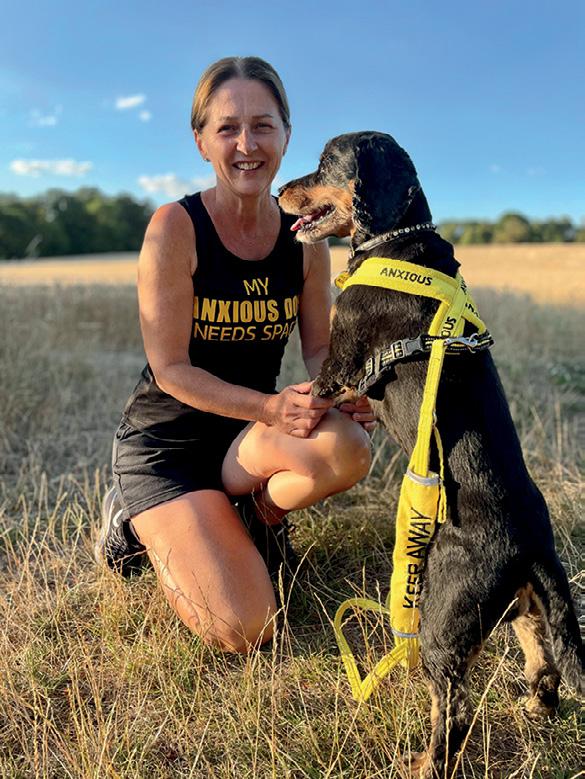
The incident has left her fearful and reactive around other dogs and strangers. Having previously needing to explain her nine-year-old dog’s needs to other dog owners who allow their dog to come bounding over to Bella off-lead, Jones decided to create a range of accessories with the words ‘ANXIOUS’, ‘KEEP AWAY’, or ‘DO NOT TOUCH’.
Jones said she had done research about anxious dogs and found that the colour yellow is the official warning colour for caution.
“It’s the colour that captures your attention more than any other colour so it can be seen from a distance.”
Jones hoped by using the colour yellow on Bella, it would indicate to other owners that they should keep their distance, unfortunately it did not.
“I put a yellow ribbon on her lead, but it did nothing. I realised I’d have to spell it out. I designed a range with ‘ANXIOUS’, ‘KEEP DOGS AWAY’ and ‘DO NOT TOUCH’ in very bold type. Instead of always having to say, ‘Please keep your dog away’, it was written in black words on her yellow harness and lead.”
Jones said walks are now more enjoyable for Bella, and Jones herself can relax and not have awkward conversations with people while their dog jumps all over her fearful dog. For more information visit bellascollars.co.uk

Smiley Dog has released its new specially formulated Organic Seaweed & Minerals range that is the perfect pamper pack for dogs during cooler weather.
Canine skin becomes dehydrated in cool weather, the same way human skin does. Although human skin and canine skin differ in turnover rate and thickness, both experience moisture loss during cool weather that is exacerbated by cold wind and artificial heating.
The inclusion of seaweed in the new Smiley Dog range works hard to not only provide added hydration but also prevent the loss of moisture. The Seaweed & Minerals range is pH balanced specifically for canine skin and is suitable for any dog, even those with sensitive skin.
The new soap-free Organic Seaweed & Minerals range is available as a retail pack for at-home use and contains a 250ml shampoo, 250ml conditioner, and matching 30ml cologne for $44.95 RRP. Available nationally via smileydog.com.au.


AniPal’s Melbourne vet founded business has created a range of functional treats designed to target common health conditions for dogs including allergies, anxiety, obesity, joint pain, and arthritis.
Bursting with natural, nutritional ingredients, AniPal’s treats also include locally sourced hypoallergenic proteins such as organic Australian seaweed and insects to offer pet owners an allergy free easily digestible option for their dogs. These novel proteins are an eco-friendly, rich source of Omegas – equally as nutritious as chicken or fish.
Get in touch to learn more about Anipal’s dental chews and hand-baked bites via hello@anipal.com.au.
The PetSafe® Pet Loo is the perfect solution for busy pet parents. This portable indoor/outdoor toilet works for dogs, cats, and small pets.
Recognising the potential that medicinal cannabis therapies can provide as an alternative and adjunct treatment, CBD Vets Australia have developed research and training programs to assist Australian veterinarians in accessing CBD treatments for their pet patients.

CBD Vets Australia ensures vets have the knowledge of the correct medicinal cannabis dosages and formulations, because pets, particularly dogs, have an increased sensitivity to the cannabinoid THC and are at risk of adverse effects
Veterinarians that join CBD Vets Australia will be able to submit prescriptions via their portal, view dosing guides, view educational videos, and have access to literature reviews, with new resources being constantly added to ensure vets are well equipped to provide top of scope care to pet patients. For more information, visit cbdvetsaustralia.com.au
The Pet Loo is a convenient and easy-touse alternative to pee pads. No more coming home for lunch or rushing home after work to let your pup out. And no more going out in the middle of the night to let your puppy do his number twos..
This convenient Pet Loo replicates real grass and drains off all urine in a flash to a hidden chamber. Trust PetSafe® to help keep your pet healthy, safe, and happy. Available at petsafe.com/au.


Zealandia offers a unique product for cats and dogs made from the New Zealand Brushtail Possum. This lively little critter likes to eat New Zealand’s rich flora and fauna, making it probably the highest source of Omega 3 from any land dwelling animal. It also targets native New Zealand birds, which is the primary reason why it is being removed from their non-native eco-system. This makes it a rich and hypoallergenic feast, with a feel good factor attached.
The canned food includes 95 per cent meat and organs, meat as the first ingredient, wild boneless protein, and a precise base of enzyme-rich green lamb tripe. Green-lipped mussel is added for hip and joint support, and king salmon oil for skin and coat health.
The continent of Zealandia is the purest on earth with deep blue seas, fertile land, and clean fresh air, resulting in a pristine environment that promotes life to flourish in good health. Zealandia responsibly sources ethical and sustainable ingredients of the highest quality from the Zealandia ecosystem and develops them into products that nourish our beloved pets to enable them to live long and happy lives.
Made in a boutique canning plant in sunny Gisborne, New Zealand, Zealandia proudly offers an exciting range of canned pet foods formulated to provide complete and balanced nutrition, keeping pets healthy and vitalised. For more information visit zealandiapets.com.
“Zealandia responsibly sources ethical and sustainable ingredients of the highest quality from the Zealandia ecosystem and develops them into products that nourish our beloved pets to enable them to live long and happy lives.”

Chewing on solid objects is second nature to a dog. In the wild, they seek out other animal bones or even tree parts to chew on to satisfy this urge and to clean their teeth and strengthen jaws and gums.
These objects are harder to find in the home environment, so it’s essential they are provided so your pet’s vital health functions can continue to be carried out at home.
Pet Pacific recommends the following dental toys: SMILE – The Ultimate Dental Ring, GOURMET – Strong Chews by Nylabone, CHOMP – Coffee Wood Chews, and NYLABONE POWER CHEW – Peanut Butter Barbell.



Pet Pacific has a range of the world’s best in no-nonsense dog chew toys.
For more information, contact the friendly Pet Pacific sales team or visit petpacific.com.au.

Eco-friendly brand AniPal has introduced a new line of recycled plastic tethering products for cats and horses, extending its existing range of fun and sustainable dog collars and leads.

AniPal’s premium products are made with high quality webbing and durable hardware, providing robustness and strength for a lifetime of use.
Each design celebrates a precious Australian species, with a portion of proceeds going towards wildlife conservation projects, striving for optimal health of both our pets and our planet. Get in touch to learn more about AniPal’s tethering products via hello@anipal.com.au.

Square has unlocked the ability for sellers in the US and Australia to now offer Afterpay across online and in-person sales.
To use Afterpay in-person, buyers simply tap to pay using a mobile wallet loaded with their virtual Afterpay card and pay over four interest free instalments. Square sellers receive their full earnings from each sale immediately.
In their first quarter together, a combined Square and Afterpay has already proven to attract new shoppers and drive incremental revenue for sellers of all sizes.
Sellers using Square Online are seeing transaction sizes increase across both the US and Australia, average transaction size with Afterpay is three times greater than non-BNPL purchases. For more information, merchants can contact Square sales or visit squareup.com/buy-now-pay-later.
Furbo has released its newest model of dog camera, the Furbo 360° Dog Camera, featuring a rotating camera to keep dogs safe and happy at home.
Following on the success of the Furbo Dog Camera, the number one best-selling pet camera on Amazon, Furbo’s newest iteration features a rotating camera with auto dog-tracking, realtime two-way audio, colour night vision, and even the ability to toss treats to your lonely pup.
Victor Change, CEO of Furbo, said Furbo’s dog detection AI technology is always getting smarter at looking after dogs at home.
“Furbo is designed by pet parents for pet parents, and we’re very excited that the new Furbo can give them extra peace of mind.”
Amongst some of the impressive AI technology is Furbo’s soundactivated barking alerts, which can detect the difference between a garden variety bark, crying, or more severe, a crucial tool for any pup parent.
Maggie Cheung, CMO and Co-Founder of Furbo, said since its launch Furbo has saved thousands of dogs‘ lives through its cuttingedge dog recognition technology.
“From our community’s feedback, we’ve developed the new Furbo with a rotating 360° view to keep even more dogs safe and happy.”
The 1080p full HD vision means the Furbo 360° gives crisp vision, day or night, and its new feature, Auto Dog Tracking, rotates to track your
dog as it moves around the room, ensuring there’s always a watchful eye on your dog.
For those working late or away from home at night, the new colour night vision feature produces colour vision in low light, while the enhanced night vision technology gives detailed images in full darkness.
While real-time two-way audio means you can seamlessly hear and speak with your pet, or other family members, while they’re at home, offering your soothing voice to help alleviate separation anxiety or even toss them a treat.
The Furbo 360° Dog Camera is available through their website or Amazon now for the special price of $319.

Puppies and kittens have natural protective systems that support their health throughout life. These consist of the immune and digestive systems and the protective shield provided by their skin and coat, which develop rapidly in their first 12 months.
They need optimal nourishment at this crucial stage to ensure their bones and muscles develop properly and to help their natural protective systems grow in harmony to optimise overall protection. That’s why Purina veterinarians and nutritionists have developed PRO PLAN Puppy and PRO PLAN Kitten formulas, to give them the specialised nourishment they need to give them a head start in life.
Puppies and kittens undergo enormous changes from the day they are born until they become fully grown:
• Their digestive system will double in weight within 24 hours of birth.
• By three weeks, the enzyme levels in their digestive system will have multiplied several times over since birth.
• As they grow, their digestive capabilities will develop as well.
After receiving their passive immune antibodies from their mother’s milk in the form of Colostrum, their immune system reaches a low at three weeks of age and remains low until five months of age. During this time, they experience an ‘immunity gap’. Therefore, they need a highly nutritious diet that supports their protective systems during this time.
A puppy’s and kitten’s coats are composed of approximately 95 per cent protein, and as much as 30 per cent of the protein in their daily diet is used for normal hair and skin growth. If their skin and coat are in poor condition, it may mean they are not getting the nourishment they need. These signs can develop much faster in young puppies because their
hair replacement cycle is shorter than an adult’s. In the puppy’s diet, linoleic acid, an important omega-3 fatty acid, vitamins A and E, plus high quality protein support a healthy skin and a protective, lustrous coat – an outward sign of good health.
Protect them just like their mother did by helping to bridge the immunity gap Puppies and kittens receive antibodies from their mother’s milk that give them a certain level of immunity. Once weaned, antibody levels will drop, leaving a gap in the protection while their own immune system develops. The immune system remains low until five months.
Introducing PRO PLAN Puppy and Kitten Dry Food. Purina nutritionists and veterinarians have developed a diet to help bridge the ‘immunity gap’ containing natural antibodies from a special form of cow’s milk (called Colostrum) that is proven to enhance the immune system and help to reinforce the natural protection their mother gave them. What’s more, these natural antibodies also help to balance the ‘good’ and ‘bad’ bacteria in their digestive tract and help them to absorb the nutrients, gain weight and thrive.
PRO PLAN Puppy and Kitten Dry Food formulas also contain DHA, an omega-3 fatty acid, to nourish brain and vision development, are made with real meat as the first ingredient, with no added artificial colours, flavours, and preservatives. New pet owners can have peace of mind that they are feeding their beloved pet everyday advanced nutrition, with scientifically proven benefits to give pets the best possible nutrition for a longer, healthy life. Available to range in pet specialty retail stores (including online), and vet clinics. If you are interested in stocking PRO PLAN, contact the friendly PetCare Advice team for more details on 1800 738 238 or visit purina.com.au/contact-us.

“New pet owners can have peace of mind that they are feeding their beloved pet everyday advanced nutrition, with scientifically proven benefits to give pets the best possible nutrition for a longer, healthy life.”
Purina nutritionists and veterinarians have developed a diet to help bridge the ‘immunity gap’ for puppies and kittens.
You are what you eat and the same is true for our pets. So, it is important to know what they are eating is good for them.
This is the core philosophy for Australian Made brand, Ivory Coat. The brand prides itself on creating high quality and delicious recipes with ingredients specifically chosen with health, safety, and nutrition in mind for your pet, and every ingredient has a role to play.
Ingredient purpose and ingredient integrity are integral parts of the Ivory Coat way of life. Every ingredient that has been added is there with the pet in mind. Artificial colours, flavours and preservatives do not fit in the brand’s fundamentals and therefore you will not see them in the ingredient list. When necessary, vitamin, minerals and other trace nutrients may need to be added to ensure all their products are nutritionally complete and balanced for the intended life stage of your pet. Meaning, Ivory Coat is designed to give your pet all the nutrients they need to thrive and no unnecessary fillers.
The Ivory Coat full range has been developed by a skilled research and development team that formulates recipes specific to the needs of pets according to their life-stage, breed, and based on the latest Association of American Feed Control Officials guidelines on nutrition and ingredients.
With Australian meat as the number one ingredient in all recipes, Ivory Coat sources its meat from approved and reputable, licensed Australian ingredient suppliers. Ivory Coat products only contain meat sourced from Australian animals that have been deemed fit for human consumption and processed in a human grade facility prior to being supplied for processing into a dry meat meal format.
All Ivory Coat raw materials are sourced as close to their manufacturing facilities as possible, to ensure guaranteed freshness and quality: Beef and Lamb are pasture-raised Kangaroo is considered free-range Chicken is derived from healthy young barn-raised birds raised for the human meat consumption Salmon and Ocean Fish are caught in Australian waters.
The number one favourite flavour in the Ivory Coat Dog range is the Grain Free Adult All Breeds Dry Dog Food Salmon and Ocean Fish, formulated without poultry, tailored for dogs sensitive to poultry protein.
Combining the Australian meat to deliver quality protein for lean muscle maintenance and carefully selected vegetables, it provides sources of grain-free complex carbohydrates and fibre to help support a healthy gut. A natural superfood blend (including tomato, apple, carrot, pumpkin, kale, blueberries, spinach, and cranberries) is added as a source of antioxidants, as well as Omega 3 and 6 to help support healthy skin and coat. A natural prebiotic is also included to support healthy digestion, and essential vitamins and minerals ensure your best mate is provided with their complete daily nutrition.

The Ivory Coat Grain Free Adult All Breeds Dry Dog Food Salmon and Ocean Fish uses an innovative technology that allows the dry dog food range to deliver better quality protein and using in vivo pet trials to ensure the same great palatability and digestibility of the range.


Not only does Ivory Coat taste delicious, but it also contains no added wheat, corn, rice or soy, and is formulated with no added artificial colours, flavours or preservatives. Only quality ingredients for a great tasting, digestible and nutritious meal.”

Ingredient purpose and ingredient integrity are integral parts of the Ivory Coat way of life.
“Only quality ingredients for a great tasting, digestible and nutritious meal.”

Appointing the right people to the Board with the necessary skills, experience in the sectors and capability has never been more important.
Words Barry CodlingAPPOINTING THE right people to the Board with the necessary skills, experience in the sectors and capability has never been more important, writes Barry Codling, President, PIAA.


The current PIAA Board recognises that to better serve the interests of our members, they must move to appoint individuals to the Board who can understand issues at both the detailed and ‘bigpicture’ level.
Board composition is a broad term that encompasses issues such as who is on the Board and the skills mix of the Board. It involves both structural and cultural issues and board effectiveness depends on obtaining the right mix of skills and experience. This is something we have lacked in the past without the ability to select board members based on a skills matrix and sound experience of the industry and something of which we wish to address with future board selection.
Stable boards with long-serving, committed members will have an advantage of a thorough knowledge of the organisation and its current mission. However, it is important that the board represents and reflects the interests of its members by having a broad range of skills to drive the Association
into the future. Selecting new directors to build a Board that is right for the Association has not been a simple task in the past.
Director selection encompasses:
• Alignment of skills with strategic direction.
• Cultural fit with the Board.
• Time it will take to be an effective contributor; and
• Succession planning.
Building the right Board requires an understanding of director competencies, which involves consideration of the directors’ experience, skills, attributes, and capabilities.
At PIAA, director appointment and reappointment will be determined by an ad hoc Nominations Committee of four Board members, comprising the Chair of the Board (who will chair the committee), the Deputy Chair of the Board and two other Directors (excluding any Directors being considered for re-appointment).
The sector working groups, which will comprise members from each sector, will meet and discuss the needs and challenges facing their part of the industry. The chair of each working group will report to the Board and work with the Directors to support our members and drive change. n
“The current PIAA Board recognises that to better serve the interests of our members, they must move to appoint individuals to the Board who can understand issues at both the detailed and ‘big-picture’ level.”
– Barry Codling, President, PIAA
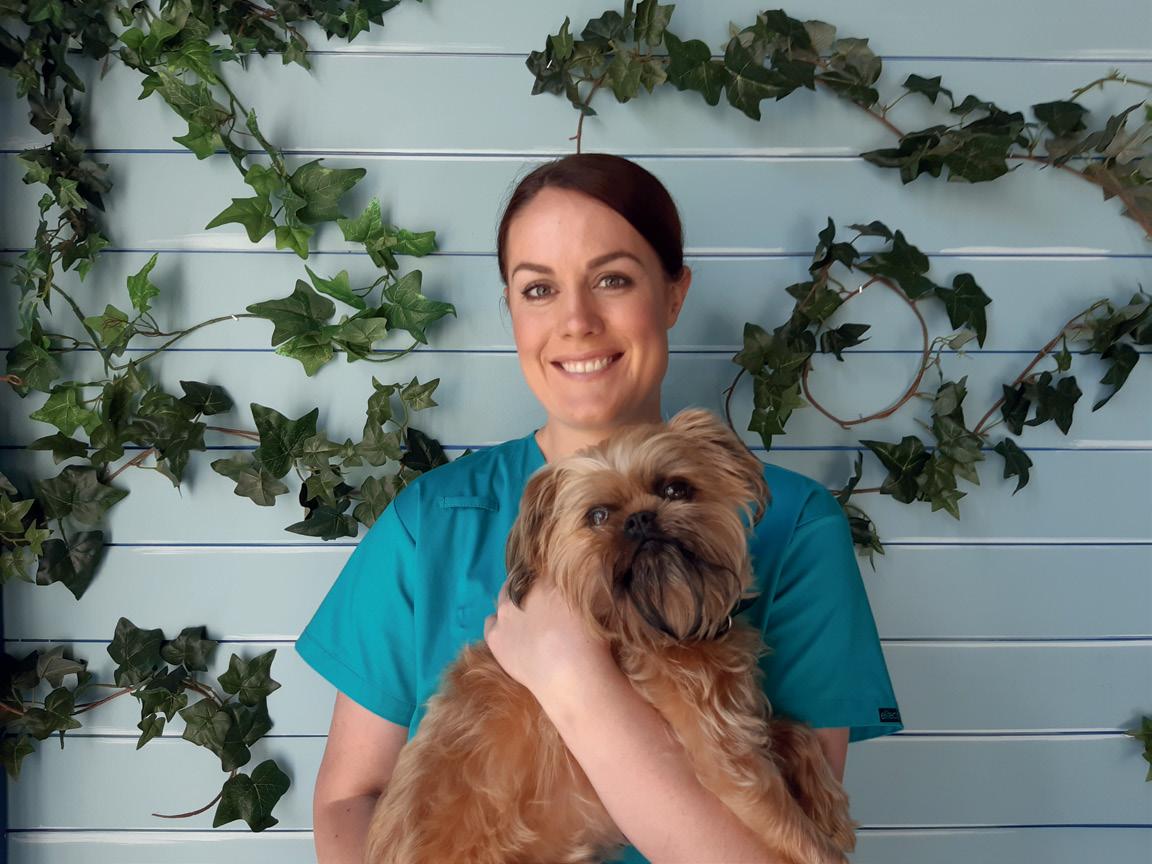
We can create a better and safer veterinary profession when the community, government and our industry partners work alongside us.
Words Bronwyn OrrAFTER THE past two years, it feels like we’ve hardly had a chance to catch our breath before diving into the ‘new normal’. The boom in pet ownership during the pandemic combined with contact restrictions saw already busy vet clinics stretched to capacity. While it may only take a few months to create a new dog, it takes between five to seven years on average to create a new vet. Veterinarians often find their work personally and professionally rewarding, however, the long hours, low renumeration, and high stress can make it a challenging role.
At the Australian Veterinary Association (AVA), we are focused on helping veterinarians thrive in their roles so they can have satisfying, successful and healthy careers. We recently launched our THRIVE initiative, which is designed to deliver a suite of programs. They include the development of a VET2VET peer support program, development of an industry-specific mental health framework and other initiatives that form a holistic approach to veterinary wellness. We strongly believe that healthy pets need thriving vets. If vets don’t feel satisfied in their careers, shortages already being experienced in our profession may worsen.
In some regional areas, clinics have been forced to close their doors due to a lack of registered veterinarians, meaning pet owners in these communities now have to drive more than two hours to receive veterinary care. Other clinics have had to close their books to new pets or introduce waiting lists for consultations. Even metropolitan areas have been affected by the veterinary shortage, with cities like Canberra now reporting an after-hours ratio of one vet to 40,000 pets.
There are a multitude of reasons why Australia is currently experiencing a veterinary shortage. We can no longer rely on overseas vets to fill our vacancies, with shortages also reported in the USA, Canada, UK, Ireland, and New Zealand. We are graduating more veterinarians now than at any other point in time. However, we have high attrition rates that peak five to seven years post-graduation. The increase in both pet numbers and client expectations has also increased veterinary workloads.

Fortunately, there are things we can do now to improve the situation.
We need to better support the veterinarians we have, by ensuring they have healthy, satisfying, and sustainable careers. Pet owners can demonstrate they are #gratefulforourvets by leaving a positive comment or review or writing a note of gratitude to their local clinic. The pet industry can support veterinarians by getting behind the THRIVE initiative and building close and positive relationships with their vets. Government can support veterinarians by offering incentives for veterinarians to service rural communities, such as HECS forgiveness and schemes that support farmers to engage veterinarians in the development of animal health and welfare plans.
Veterinarians enter this profession because we want to help animals and their owners. Healthy pets need thriving vets, and I believe that we can create a better, safer profession when the community, government and our industry partners work alongside us. At the AVA, we will continue to advocate for veterinarians across all sectors of society until every veterinarian has the chance to lead a satisfying and successful career. n
“We are focused on helping veterinarians thrive in their roles so they can have satisfying, successful and healthy careers.”
– Bronwyn Orr
An increasing number of marine Angelfish are becoming available on the international market

The AIAA continues to advocate for its members and the broader aquarium industry.
 Words Jared Patrick
Words Jared Patrick
THE AQUARIUM Industry Association of Australia (AIAA) continues to facilitate the applications of the nine species of fish to being applied for to potentially be added to the permitted import list. This is a slow and tedious process, but we are working through it. We are currently updating each species’ application with the additional information that the Environment Department has requested, and we expect to have our updated applications resubmitted by the end of August 2022.
marine fish importers and retailers is that captive marine fish are not able to be imported, whereas captive freshwater fish make up the predominant part of imports. This makes no sense and is primarily due to captive marines being essentially unavailable when the import restrictions and requirements were drawn up. This has not changed significantly with many captive-bred Clownfish, and now an increasing number of marine Angelfish being available on the international market. We continue to lobby the Biosecurity division of the Agriculture Department to commence this review. Unfortunately, they always say that there are higher priorities in front of our requests.
We continue to stay alert to relevant issues around our country that impact our members and the aquarium industry generally.
Captive-bred Clownfish are not able to be imported, whereas captive freshwater fish can be
The AIAA continues to advocate for its members and the broader aquarium industry. Now is the time to join if you’re not a member – head to the website aiaa.net.au to join now. n

“We continue to stay alert to relevant issues around our country that impact our members and the aquarium industry generally.”
– Jared Patrick
Pet retail has come a long way and is continuing to grow and evolve.
I HAVE fond childhood memories of wandering down to my neighbourhood strip shopping centre and staring through a shopfront window into a world of furry and ‘exotic’ creatures at the local pet store.
There was always a chorus of noise led by boisterous budgerigars, guinea pigs scuttling around their enclosure, all sorts of cold water and tropical fish, and cute kittens and puppies on display, usually asleep on their straw beds.
Alongside the stars of the store were all sorts of pet toys, collars, and leads, food and medicines.
My distant memory of the store was that it was cluttered and stacked high with products in no apparent order except where the proprietor deemed to be a ‘good spot’ at the time.
This approach seemed to work back in the day when shopping strips were the centre of local communities, life was lived at a more leisurely pace and items were procured by business at the request of the customer (early iteration of the personalised shopping experience).
Fast forward to 2022 and while we can look back with a nostalgic tear in the eye, it is difficult to see how any pet supply store could survive, let alone prosper, without evolving their offering to meet ever increasing customer expectations for their furry, finned, and feathered friends.
Winston Churchill is credited with saying, “He who fails to plan is planning to fail,” and nowhere is this more applicable than in the fast-paced environment of FMCG retailing.

Pet store shoppers of today are more time poor than those of yesteryear and expect to be able to navigate their way through the front door, get their bearings, complete their mission, pay for their purchase, and make their way out of the store with a minimum of fuss and time.

This desired outcome doesn’t happen by chance. There is nothing more infuriating than walking up and down aisles looking for a product or staring at empty slots on the shelf once you manage to locate the area where the item being searched out should be located.
According to conventional wisdom, a dissatisfied customer will tell up to another 20 people about their poor experience once they leave the store. This fact alone
is a powerful motivator to make sure that each and every customer has the best possible in-store experience.
While you can’t please all the people all the time, you can plan to give the majority of customers a great experience.
Retailers including sole proprietors, multi-site operators or larger chains, regardless of size, have a wealth of information and data to draw upon to help with planning and guide them.
Whether it’s staff observation, conversation with loyal customers, trade partner information or secondary data – or a combination of all of these. This information will help to organise store layouts based on departments or clusters of ‘like’ categories, range of products in which categories, and where they all go.
There are basic principles that apply across all retail stores that should be considered.
The transition area – is the first three to five metres at the store entry clear? Shoppers need some clear space to orientate themselves with the store layout when they first enter.
Clear signage – directive, bold and easy to sight. Particularly important for first time shoppers who may be dissuaded from venturing the length of the store if they are uncertain about where the dry dog or cat food is located.
Store flow – clear and uncluttered. Providing a clear line of sight to the category or categories that shoppers are looking for with clear access to shelves and fixtures.
Shopability – category adjacencies. Are collars and accessories best positioned near the dry dog food or treats? What makes sense according to your clientele?
High margin ‘add-ons’ – is there opportunity to place high margin items at or near the point of purchase to gain incremental sales and increase spend?
While these are all solid retailing principles, there is no absolute guarantee of success. However, a well thought out and planned approach complemented with executional excellence and attention to detail will attract and retain loyal customers, ensure reduced out of stocks and lost sales, and ultimately maximise your investment.
We have come a long way from the pet store of my childhood and I have no doubt the industry will continue to grow and evolve. n
Words Stephen Wilson
“A well thought out and planned approach complemented with executional excellence and attention to detail will attract and retain loyal customers.”
– Stephen WilsonStrikeforce
There are many things to consider when a child wants to own their first pet.
Words Bob Croucher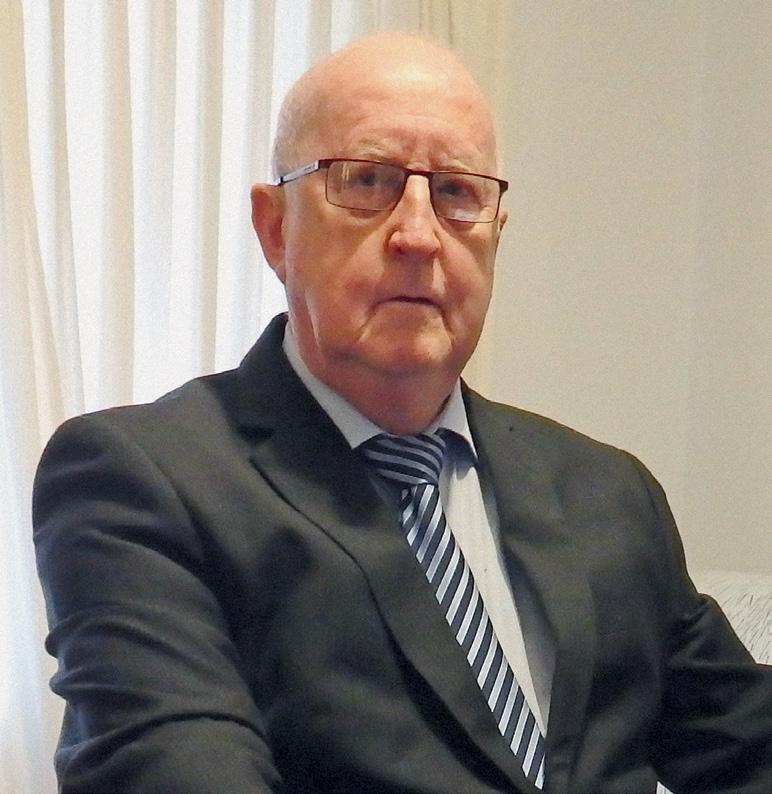
THERE COMES a time in a child’s life when they ask their parents for a pet. For most animals they will go to a pet shop or breeder.
Research has shown that children who grow up with pets are likely to have better nurturing skills as adults and are perhaps even higher achievers in life.


Of course, if a younger child comes to the shop, it should be explained that the decision to add a pet to the family should be discussed with all household members, as the pet will be an addition to the family. The pleasure of ownership will be shared by all family members, but with the pleasure comes the responsibilities. You would also explain that a parent or carer would need to come to the shop so that you
can be sure the rest of the family are agreeable to having a pet in the house.
Depending on the age of the child they cannot be wholly responsible for the care and wellbeing of the animal. An adult family member must also be prepared to accept the responsibility and oversee the child’s feeding, cleaning, training, and interacting with the pet.
The choice of a pet is important, dogs may be more suitable for families where someone is home for most of the day, cats are more independent and go better with time spent alone, remember that animals also require companionship, and two animals will be company for each other in your absence as well as providing double the fun.
Rabbits and guinea pigs can be cheap to keep although initially their housing may be more expensive than that required for a cat or dog. Birds, particularly budgerigars, can be cheap to purchase and easy to keep.
A benefit of pet ownership to children is the wonderful companionship they can provide. All children and pets seem to spend a great deal of time deep in conversation.
Pets also teach responsibility and although the children themselves may not be able to provide the primary care for the animal, they will by observation learn that responsibility. You should learn that when
“A benefit of pet ownership to children is the wonderful companionship they can provide.”
– Bob Croucher
the pet is added to the household it is a permanent member, one that’s needs and wants must be provided for, and not a disposable item to be discarded when it’s needs become inconvenient.
Life’s lessons of birth and death can also be taught from pet ownership, although before allowing the pet to reproduce the family should be prepared to accept responsibility for finding good and caring homes for the prodigy. If a dog, cat, rabbit, or guinea pig is not intended for breeding then speak to your local vet about desexing.
Children should be taught that animals are not just toys, and that the animal has emotions and needs. When a new puppy or kitten is brought home, children are very often anxious to play with it, but like human babies, young puppies and kittens spend the majority of their time sleeping. Short bursts of play interspersed with eating and sleeping are necessary. If a puppy or kitten is not allowed to sleep when it needs to, it will quickly become annoyed or frightened of the children.
The animal should have a quiet area where it can go to rest and the children should be taught that when it goes there it must be left alone.
Very young children should not carry animals as a squirming animal is very likely to be dropped and injured severely. Young children may also injure birds by holding them too tightly and playing with dogs should be supervised until the dog and child are confident with each other and know how to play together. Cats are much more able to escape from the unwanted attention of children.
After the child requests a pet for a birthday, the purchase should not be hurried. If the choice is a dog or cat the animal may be your child’s best friend for up to 15 years. If the choice is a parrot, it may see your grandchildren born, rather buy a book on the

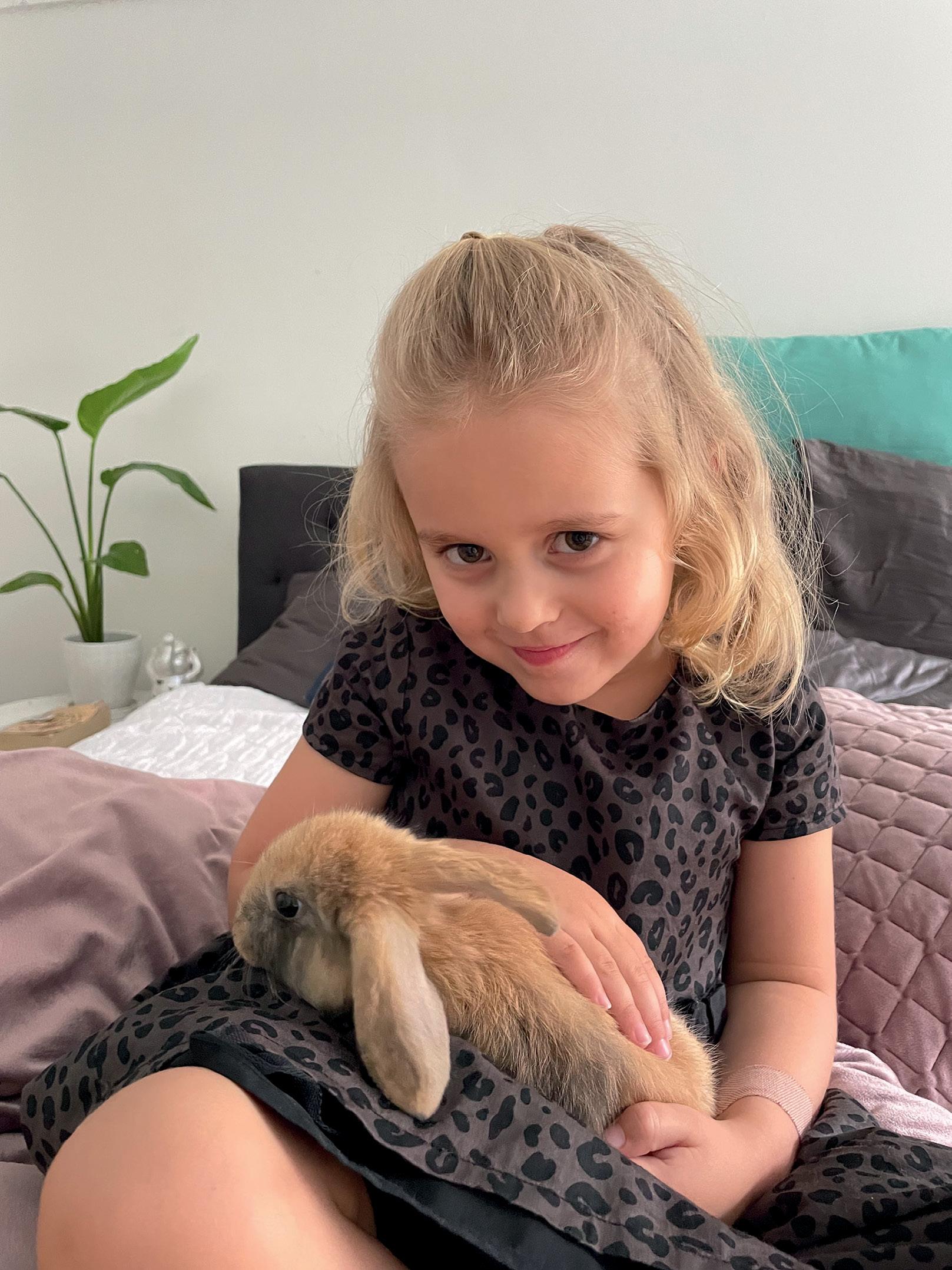
breed or species and then pet accessories with the animal to follow later.
For the retailer, in your conversation, enquire if they have considered an animal from a shelter, I have never lost a sale by that conversation. While you are preparing the paperwork suggest they go and have a coffee (shout them if you feel comfortable about that) and talk between themselves. This way you are most likely to ensure the animal will go to a good home. n
“All children and pets seem to spend a great deal of time deep in conversation.” –Bob CroucherA benefit of pet ownership to children is the wonderful companionship they can provide
A warning to pet owners when it comes to pet food fads. Words Zara Boland and Michael Zajac
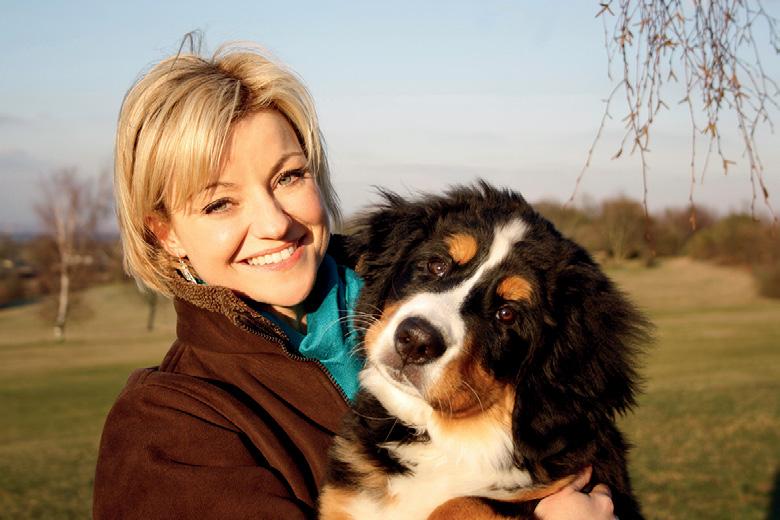
THE INTERNET is a source of wonderful information with innumerable resources available at the touch of a button. Anyone can find corroborating ‘evidence’ that reinforces their opinion, but some topics repeatedly rise to the surface. For example, do cats and dogs truly need carbohydrates and why choose manufactured ‘cooked’ food over a more ‘natural’ raw diet?
Grains are a rich source of nutrients for pets. They are the seeds of cereal grasses such as oats, barley and corn and help to meet the body’s fundamental need for glucose, which is an essential source of energy. Whole grains typically contain about 65-75 per cent complex carbohydrates and less than two per cent sugar. They also provide protein, fibre, essential fatty acids, B vitamins and minerals.
Wild dogs and wild cats don’t eat carbohydrates, so why should my pet?

Dogs and cats do not have an essential nutritional requirement for carbohydrates in their diet. Energy can instead be obtained through the metabolism of proteins and fats. However, this is not only an inefficient way to obtain glucose for energy, but it also diverts the use of protein and fat from other vital body processes and functions.
Proteins are complex molecules required for the
function, structure and regulation of body tissues and organs. Examples of which are antibodies required for normal immune response, hormones to transmit signals between cells and the basic structural components required to create muscle, skin, hair, and nails. When energy is not readily available from carbohydrates in the diet, the body will preferentially divert proteins (and fats) away from these many essential processes to create glucose.
Genetic studies have demonstrated that as modern dogs evolved from wild canids, they also acquired more genes that code for enzymes, which help them to digest grains1. Domestic cats on the other hand are obligate carnivores, like their wild ancestors still living today and need certain nutrients found naturally in animal tissue. However, this does not mean that they can only eat meat or should not eat grains. Cats uniquely use different metabolic pathways than other species for digesting carbohydrates, but scientific research has demonstrated that cats can digest and use grains with an efficiency greater than 90 per cent2-4
This is an area that draws lively discussion amongst vets, nutritionists, and pet owners alike, so let’s start with the basics. A raw food diet is an uncooked diet normally comprised of the following ingredients:

muscle meat, bones (whole/ground), organs (typically liver/kidneys), raw eggs, dairy, fruit and vegetables. Diets marketed as BARF mean that they are either comprised of ‘bones and raw food’ or ‘biologically appropriate raw food’. The concept upon which they are all based is that dogs and cats originally ate raw food (predominantly through predation) before domestication and returning them to this type of food will improve their health and longevity.
Many proponents believe that raw food is associated with a shinier coat, healthier skin, cleaner teeth, increased energy levels and improved digestive health. However, research is ongoing and to date there is no robust published scientific evidence that supports these claims. Some small studies have suggested benefits that stool quality is subjectively improved on raw diets, but further research is needed to draw firm conclusions.
“Feeding raw meat to your pet poses a threat of illness, not only to your pet, but also to all members of the household.”

The flip side is that raw meat and poultry contains pathogens such as bacteria, parasites and protozoa including Salmonella5. Feeding raw meat to your pet poses a threat of illness, not only to your pet, but also to all members of the household. There is also an emerging concern that some of these bacteria may be resistant to antimicrobials and consequently feeding raw diets could help to spread antibiotic resistant bacteria. Bones (either raw or cooked) can fracture teeth, cause choking and damage or obstruct the gastrointestinal tract. The other main concern is that raw (and particularly homemade raw) diets may not be nutritionally balanced or complete with all the nutrients required for each pet’s particular needs5. Calcium deficiency can lead to impaired growth, spontaneous fractures, and loose teeth. Vitamin A toxicity can occur if large quantities of raw liver are
nutritionist) has formulated the raw food diet that you give to your pet, there is a high risk of malnutrition if fed for any extended period of time. n
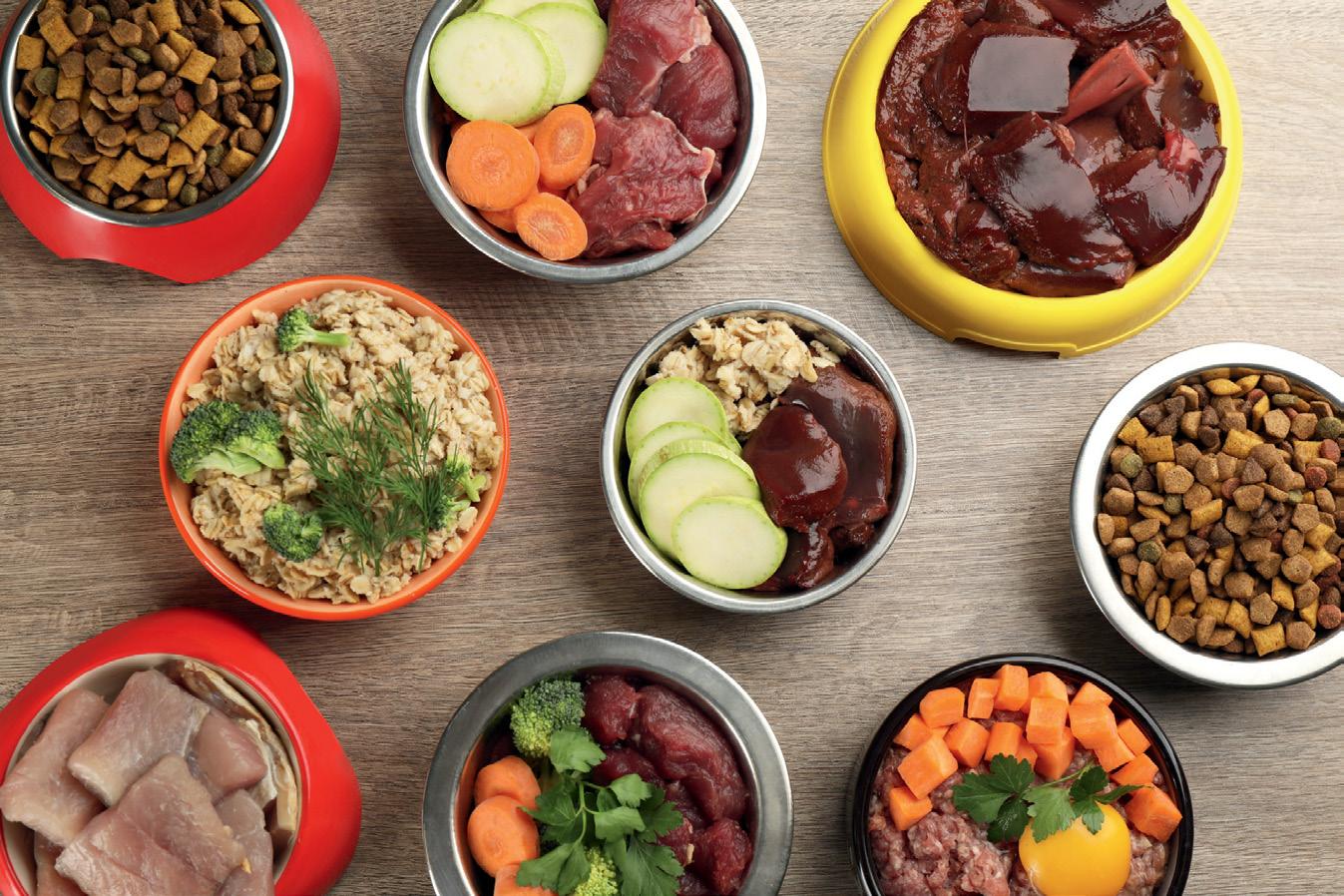
Sources:
1 Axelsson, E., Ratnakumar, A., Arendt, M.L., Maqbool, K., Webster, M.T., Perloski, M.,...LindbladToh, K. (2013). The genomic signature of dog domestication reveals adaptation to a starch-rich diet. Nature, 495(7441), 360–364. doi: 10.1038/ nature11837
2 de-Oliveira, L.D., Carciofi, A.C., Oliveira, M.C., Vasconcellos, R.S., Bazolli, R.S., Pereira, G.T., & Prada, F. (2008). Effects of six carbohydrate sources on diet digestibility and postprandial glucose and insulin responses in cats. Journal of Animal Science, 86(9), 2237–2246. doi: 10.2527/jas.2007-0354 5.
3 Kienzle, E. (2009). Carbohydrate metabolism of the cat 2. Digestion of starch. Journal of Animal Physiology and Animal Nutrition, 69, 102–114. doi:10.1111/j.1439- 0396.1993. tb00794.
4 Tanaka, A., Inoue, A., Takeguchi, A., Washizu, T., Bonkobara, M., & Arai, T. (2005). Comparison of expression of glucokinase gene and activities of enzymes related to glucose metabolism in livers between dog and cat. Veterinary Research Communications, 29(6), 477–485.
5 Schlesigner DP, Joffe DJ. Raw food diets in companion animals: A critical review. Can Vet J. 2011;52[1]:50-54
“Cats uniquely use different metabolic pathways than other species for digesting carbohydrates, but scientific research has demonstrated that cats can digest and use grains with an efficiency greater than 90 per cent.”

There are countless great stories about real animals and the pet industry needs to use these to get the media’s attention.
Dr Harry Coopervery old saying, but oh so true, ‘Bad news makes news, but good news is no news’. So how do we , it was certainly obvious to me that people actually wanted to hear good stories about animals, whether they be our pets or animals in the wild. It used to be just a 30 second ‘grab’ that TV channels used to put a smile on viewer’s faces, after all the misery of the nightly news bulletin.
I was so convinced that we could do more than just run the mandatory three and a half minute info piece each week, as I was doing, that I took a proposal down to the local television channel in Hobart. It had taken quite a deal of research to come up with all the right figures, such as population numbers, money spent on food and accessories, veterinary fees of course, and anything else I thought relevant. It had unique ideas, looking at all aspects of domestic animals and basically anything else that could crawl, walk, slither, gallop, swim, or fly! It could have been called, ‘All About Animals’.
Having taken a seat in the manager’s office and presented the proposal, he and his offsider turned away and looked out the window, muttering
something about fishing, I thought. Finally, they turned back, and staring straight at me, he uttered the words that have spurred me on for more than 50 years: “Animals, Harry? Honestly, who would want to watch a show about animals?”
Well, it was only a couple of months later I was having lunch with Brian Finch from FM Television in Launceston, and he was showing me a proposal that was very similar to the one that I had filed under ‘try again later’. We did just that together and Talk to the Animals was born! Wow!

We started filming in October, with the object of launching the show in another 15 months, but the Seven Network thought differently, and it was the end of January, some four months later we were on air.
It became compulsory Sunday night viewing with audiences of more than 3.5 million, yes, million. It ran for four years, and regrettably, like so many series, it folded. But when that one door shut, another opened and 12 months later ‘Harry’s Practice’ was born. Dr Katrina Warren and I formed what I like to think was a great team, but we had a great producer, Hilary Innes, who steered the show to the great success it
Emotion is what’s needed.”
– Dr Harry Cooper
was. It took ‘The Block’ to finally see us off. It’s a wonderful feeling that more than half of the students enrolling in the faculty of Veterinary Science around the country were motivated by that series. That is the power of media!
That, however, was not the end and I was asked to join ‘Better Homes and Gardens’. I’ve lost count, but around 18 years seems about right. I’ve looked back at the start of my television adventures, and it seems that it was 1969 when I first stood in front of a TV camera. It was the ‘Today Show’, mornings, on the Seven Network. What did we talk about? Animals! What else?
In total, probably half my years have been spent in front of a TV camera, and I wouldn’t change it for the world.
It seems that in spite of my initial knock back, the whole country embraces animals. Television commercials, a spot on every news bulletin, billboards, and the written word. Social media is awash with animals. They make us laugh and they make us cry, two of the great human emotions that make us remember things and events.
We can of course just choose to sit around and expect things to come to us in business, or we can get out there and promote. It is up to everyone in business to keep the object of their activities front and centre in eyeline of their potential audience. It’s of little value, in my book, talking about dogs as a group. What your audience needs is stories, true stories, of animal ‘heroes’. Stories that 95 per cent of the time have a happy ending. Everyone likes a happy ending.

Sure, there are times when circumstances dictate otherwise, like the loss of between one and three billion animals in the last major firestorm, but this needs to be balanced with stories of survival and success. The tales of koalas that make it through seemingly horrific burns, to live life again. Who can forget that picture of such a creature taking a drink from a firefighter’s water bottle?
I was always moved by the story of an elderly owner collapsing in his own home and being unable to call for help. His trusty dog kept him alive for five days by dunking a towel into the toilet and bringing it to him so he could get a drink. What a dog!
Our great Australian poet Banjo Paterson wrote about ‘Mongrel Grey’, the only horse that would swim a flooded river in the dark to save a child’s life.
Great stories about real animals.
We are all concerned about the legislation governing dog breeding in NSW. Is it in fact going to legitimise commercial puppy farming and bring an end to the ‘mum and dad era’, where the family’s dog was allowed to breed a litter of puppies every couple of years? Frankly I do not know, but surely the general public are interested in situations like this.
As a group it is up to people like yourselves in the pet industry to approach the media. They will rarely come to you unless it is one of those ‘bad stories’ I spoke about at the very beginning.

Facts are important, but they rarely grab peoples’ attention. A story about real people, real animals, and real events is what you need to get the media’s attention. Emotion is what’s needed.
Communication is the key. We must learn to utilise all possible media outlets to spread the word that owning a pet is just the best thing in the world. It’s not much value carrying on about the science, even though we know how true it is. Your job as business owners is to find these stories, or if time does not allow, then find someone who can find them for you. Do I sound like I’m repeating myself? Good, you noticed, keep knocking on doors. That my friends is the key.
QUESTION: “Animals? Who’d want to watch a show about animals?”
ANSWER: “Just about everyone.” n
“We must learn to utilise all possible media outlets to spread the word that owning a pet is just the best thing in the world.”
– Dr Harry Cooper
Emily Hill, Senior Consultant at IRI, examines current pet care trends and how retailers can improve their online game.
AS GROWTH in pet ownership increases, undoubtedly so will the trends associated with the industry. To discover more on these trends, Pet Industry News sat down with Emily Hill, Senior Consultant at IRI, to discuss what she’s been seeing in the category.
Pet: Have you noticed a growth in what pet owners are spending online?
Hill: We’ve seen a huge growth of almost 50 per cent across the Petcare category across all segments. This is in line with growth of overall pet population during the Covid lockdown period.
While the main segment, Pet Food, is growing strongly; the category growth is predominantly led by the Pet Accessories segment as pet owners are looking to play with their new furry friend or keep them entertained while working from home.
Pet: Are pet owners favouring online versus in-store?

Hill: The majority of pet owners still shop in-store, with market penetration registered at 94 per cent but it’s declining by -1.6pts. Online has seen a huge surge in penetration growth (+7.0pts vs. YA) as pet owners are becoming more accustomed to the channel as a result of last year’s lockdown.
With online, shoppers are able to buy larger and bulkier packs, particularly within Pet Food, as the products are delivered to their doorstep as opposed to having to carry it themselves if they were to buy in-store.
Pet: What has driven the boost in online shopping?
Hill: Overall, online has recruited new households as shoppers (especially younger households) have been embracing the channel since the lockdown period last year.
We also see that online shoppers are spending more dollars per online
transactions, taking advantage of the minimum spend in order to get free delivery.
Pet: Based on your insights, what advice would you have for pet retailers to get the most out of their e-commerce ecosystems?
Hill: Plan for an ongoing migration of customer spend to online transactions and invest/accelerate strategies that provide a better customer experience covering the following six buckets:
1. Have it – ensure a broad enticing range that is constantly in stock. Not getting the product on shelf is the number one frustration of online shopping and this is something we’ve seen a lot in Petcare over the past year, particularly in Wet Cat brands. Invest in digital shelf analytics to track own and competitor availability.
2. Find it – this is more challenging as the majority of shoppers use their previous purchase, therefore if your brand isn’t in the basket already, it can be challenging to disturb the shopper trip. Winning the battle for online search performance is key.
3. Price it – incorporate ‘online only’ specials into promo planning.
4. Display it – ensure product titles and details align with search term usage and boost visibility with product listing advertisements across differing online pages – i.e. homepage and search and browse product detail page (PDP).
5. Fulfil it – tap into the rise of quick-commerce/rapid delivery.
6. Support it – establish in-store touchpoints to attract, engage and retain the omnichannel shopper.
Hill: Very! Pet owning households have been identified as very valuable cohorts from a sociodemographic perceptive. Pet owners spend $31 more per online shopper trip than non-pet owners and embark on two per cent extra shoppers trips, highlighting the value opportunity for pet retailers.





JUST AS there has been increased scrutiny on human gut health, so too has there been on animals with many people now identifying the effects that both good and poor gut health can have on your pet.
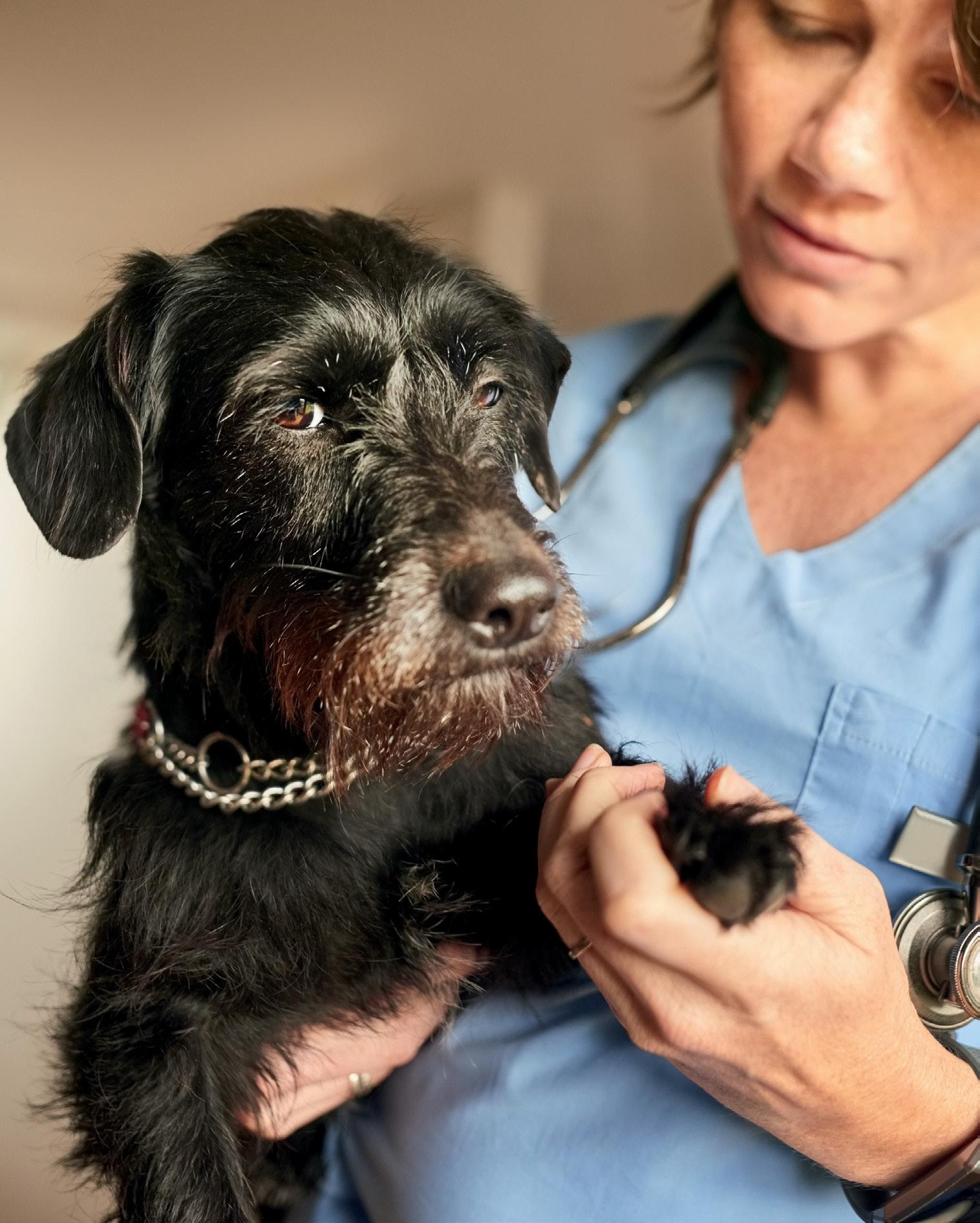
This has led to new products entering the market to cater to this need, including Poseidon Animal Health, which initially catered to the gut health of horses but has recently released a new line of gut health products aimed at dogs.
Linda Goldspink-Lord, creator of Poseidon Animal Health, said that stress, medications, diet, and management all play a role in shaping our dog’s gut health, and that as research increases across all species, we are now understanding the importance of creating good gut health.


“These days, many of the dog foods on the market are highly processed and contain low pet grade ingredients, synthetic supplements, artificial colours, flavours, and preservatives. Our dogs can also be exposed to a number of chemicals and pollutants in their diet, medications and environment; and they can experience emotional unease.

Poor gut health is a hot topic in both humans and animals, but what is it, how do we identify it, and how do we help solve it?
“For any body system to work optimally we need to ensure we are feeding the right nutrients, in the right balance, and in the right format that can be successfully absorbed and utilised by the body.”
Stephanie Stubbe, Founder,
“Stress plays a major role, too. Loneliness, separation anxiety and lack of exercise can also contribute. Some of these stressors are unavoidable, so maintaining good gut health to cope with stress is important.”
Dr Corey Regnerus, BVSc BSc, on behalf of the Pet Food Industry Association Australia (PFIAA), explains the gut is where our microbiome lives – a complex ecosystem of bacteria and organisms, which ensures the entire body remains in good health.
“It allows for food to be digested and nutrients to be absorbed, so when gut health is poor, our pets do not benefit from nutritious food.
“The microbiome is also home to 70-80 per cent of the body’s immune system so a healthy gut is vital in maintaining overall health and fighting off severe disease.”
Regnerus said that gastrointestinal abnormalities or disease can be complex and possibly multifactorial in nature meaning that they can be challenging to manage, and that time and patience is needed with veterinarians as they work through a range of diagnostics and treatments to pin-point causes of gut health.
“Even with complete workups for gastrointestinal disease, majority of the time the single cause isn’t identified.

“In nearly every case, dietary management is used for either treatment or management of clinical signs.”
Stephanie Stubbe, veterinarian and founder of AniPal,
agrees that an unbalanced or a not appropriately digestible diet is often the cause for poor gut health.
“Just like humans, for any body system to work optimally we need to ensure we are feeding the right nutrients, in the right balance, and in the right format that can be successfully absorbed and utilised by the body.
“The first and most effective way to support your pet’s gut health is to ensure you are providing a balanced and wholesome diet. This can be difficult to determine as there are many diets on the market that are technically complete, but the nutrients are not bioavailable for the pet. This means they are not in a format that the pet can absorb effectively. This can lead to poor digestion and microbiome disruption.”
While it’s all well and good understanding how gut health can impact your pet, how does a pet-owner identify then rectify the problem?
Regnerus said a barrier to owners utilising gut health supplements may be that pet owners aren’t aware of the signs of poor gut health or simply not sure what they need to look for in a supplement.
“The first sign that gut health isn’t where it should be is most often stool quality. Pet owners may notice soft, foul smelling or liquid stools when cleaning up after their pets. Another sign may be flatulence or increased frequency in defecating. These signs may also lead to weight loss or overall poor health and immunity.
“In many cases, pet owners only have a comparison of their own pet. Abnormal stool consistency might be seen as ‘normal’ for that pet and not seen as a concern to raise with their veterinarian.”
Stubbe, says that identifying the problem requires consultation with a veterinary professional to complete a thorough diagnosis.
“To investigate the signs of your pet and the gastrointestinal tract, your vet will take a full history and do a physical examination of the pet, take a stool sample, + / - blood test and imaging if indicated. From here the vet can determine the best treatment plan to commence.”
Goldspink-Lord believes many owners don’t understand the link between gut health and some of the problems their dog is experiencing.
“Smelly farts, gross poops, bad breath, blocked anal glands, constant paw licking, upset stomachs, painful skin, and anxious behaviours are stopping our dogs from living their best lives and are related to their gut.”
While a healthy diet can go a long way to support gut health, Goldspink-Lord says sometimes it might just need a little help.
“Because our dogs are exposed to many gut stressors, using a high-quality gut supplement is of great benefit. Choose one that focuses on supporting the dog’s digestive system and doesn’t contain any fillers, colours, or artificial preservatives, doesn’t contain any synthetic vitamins or minerals, is developed with a canine expert, and contains ingredients with benefits supported by scientific research.”
“Even with complete workups for gastrointestinal disease, majority of the time the single cause isn’t identified.”
– Dr Corey Regnerus, BVSc BSc










A week of learning, networking, and fun was had at the 2022 Indepet Conference, held at Sea World Resort on the Gold Coast.

The Indepet Conference featured a range of knowledgeable speakers and provided the opportunity for retail members to connect directly with suppliers.
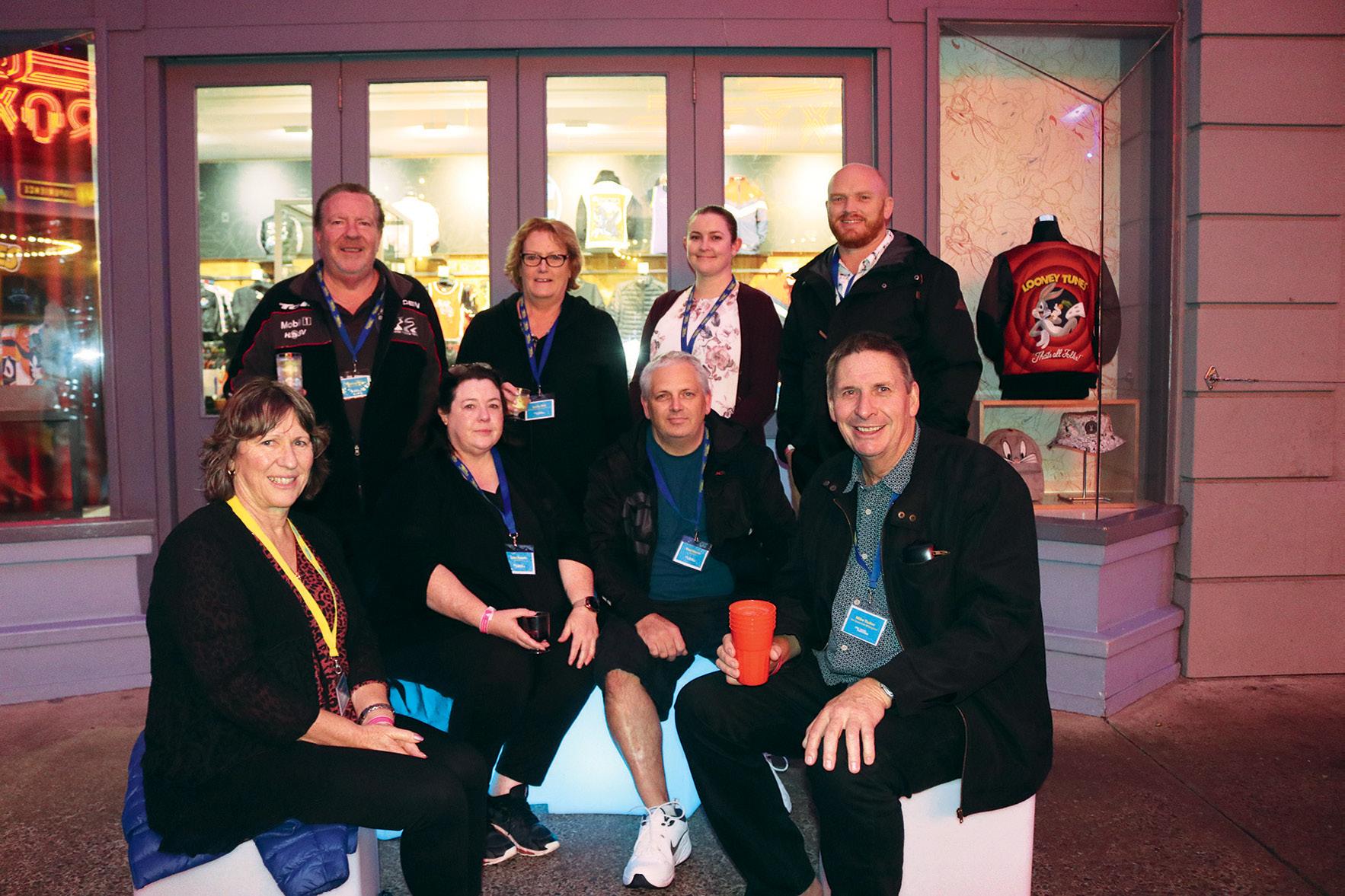

CEO Todd Clarkson also revealed Fiji as the location of the 2023 Indepet Conference.
“One of our values here at Indepet is to ‘Enjoy the Ride’ and after a few years of being stuck behind closed borders we feel confident that we can expand our horizons a little bit more and provide a great event that will be the perfect mix of work and play… and what better way than with the white sandy beaches and clear oceans of Fiji!”
John Counihan, from Mt Barker Pet Centre in Adelaide, said the conference was invigorating given the recent lockdowns and it was great to catch up with old acquaintances and make new connections.
“I’d absolutely recommend attending the Indepet Conference. I think going forward, it protects an independent model, not only financially but also in networking and collaboration, and it’s also a lot of fun.”

Michael Strike, from Elanco said it’s been great to be able to connect with stores but to also learn more about Indepet and their plans.
“It was well setup with a good balance of work and connecting. An aim for us was to understand how we can support the stores better. Find out what they need, what will work for them, and just make sure we’re looking after them in the right way.”
Alira Willcocks from Prestige Pet enjoyed being able to catch up with people she hasn’t seen in a long time and to see all the new products in different industries.

“I’d recommend coming along in the future. The orders coming through have been amazing so far, so it’s going to be good to see a lot of our new ranges in most of the stores.”
Katie Parker from Gold Coast Pet Centre, said the conference was enjoyable with lots of information and learning and of course lots to


“It’s good to be part of a group and have support from other stores. We lean on a lot of the other stores, and offer them help too, so it’s good.”
Gene Maurice, Royal Canin, said the conference was productive and it was good to catch up and understand what the strategy of Indepet’s longer term goals under Todd Clarkson’s new team.

“Independents are a big part of our business overall, they’re important to us. Indepet is a great support network that brings us all together and puts it in one place. Also, from Indepet’s backend and administration point of view, for them to be able to support our brand is beneficial and creates awareness right across the country.”

Paul Cosier from Virbac said is was his company’s first time at the conference and it has been really good and engaging as well as a great opportunity to get their products out there.
“If you’re not at these things, retailers don’t get to see all your products and what you have to offer, so I’d definitely encourage coming along. We’ve got some good orders, and we have a few new products so we’re getting those out into the market.”

“I’d absolutely recommend attending the Indepet Conference. I think going forward, it protects an independent model, not only financially but also in networking and collaboration, and it’s also a lot of fun.” – John Counihan, Mt Barker Pet Centre
Bindweld can create any number of point of purchase solutions to ensure your product is front and centre with consumers.
The best way to showcase your product within a busy and often clogged space is via point of purchase solutions. Bindweld is a local manufacturer with more than 40 years of experience in creating, customising, manufacturing, and delivering innovation by design.

With an internal graphic and industrial design team at your disposal, Bindweld can create any number of solutions to ensure your product is at the forefront of your consumers thoughts.

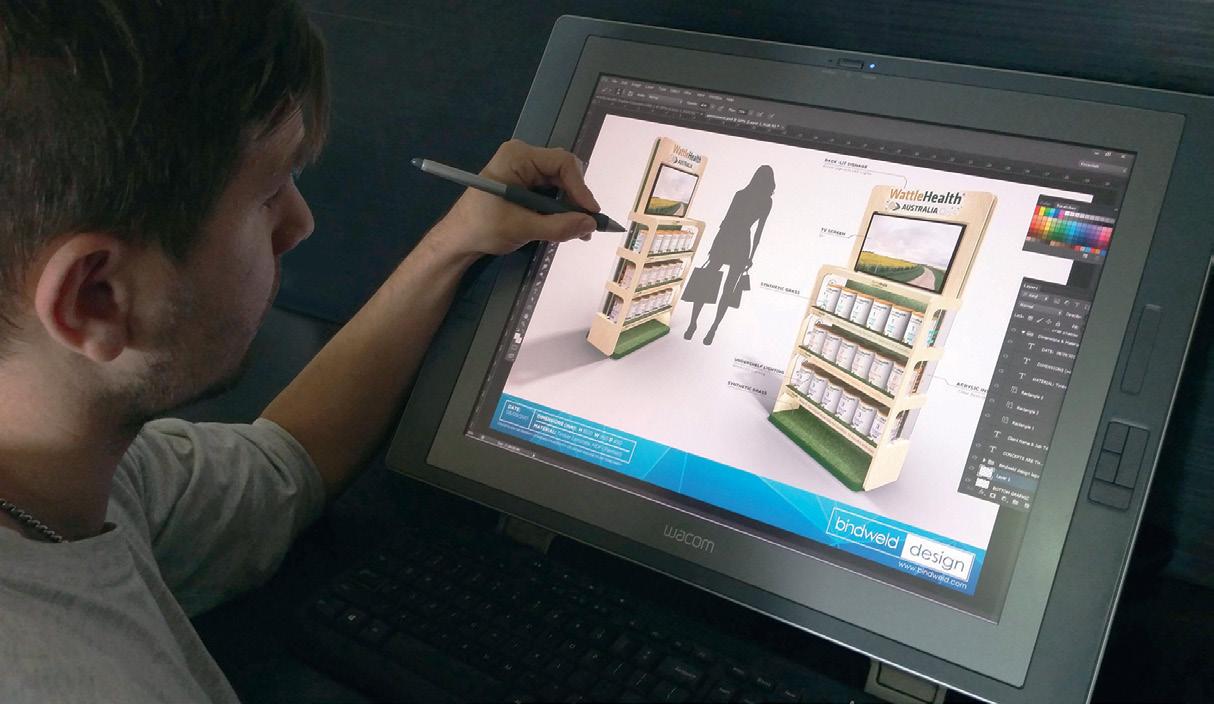

Bindweld creates and locally manufactures hangsells, clipstrips, CDUs, shelf interrupters, floor stands, dump bins, vacformed trays, full pallet displays and much more. Using a variety of materials such as polypropylene, cardboard of all gauges, flute board, acrylic, plywood, Foamex, and metal.
Bindweld also sources and manufactures offshore for clients when the timing and quantities allow. With more than 15 years of experience doing this, Bindweld can handle the brief from the design stage to the final stages of delivery and even assembly. Ensuring there is only one contact point for the entirety of the project.
The process simply starts with a brief, and the Bindweld team does the rest. Starting with concept sketches and renders, creating the platform to provide quotes and preproduction samples if required.
All of this is done with more than 40 years of experience with manufacturing within the FMCG, convenience and impulse and pet care space. Bindweld has multiple designers, print machines, die cutters, glue machines, vacformers, a laser cutter, CNC router and heat bending machines all in house capable of creating your next masterpiece.
Bindweld is also very mindful of the environmental footprint it leaves when producing these items. This is why it is now proud to offer a 50 per cent recycled cardboard option, and 100 per cent recycled polypropylene sheet to its customers. These materials are not only recyclable, but can be reused and recycled when they reach the shop front. For more information on the offering, you can get in touch with Bindweld to arrange a meeting via email at sales@bindweld.com or by calling 03 9466 1933.
“Bindweld is a local manufacturer with more than 40 years of experience in creating, customising, manufacturing, and delivering innovation by design.”
Royal Canin has appointed Cécile Coutens as its new President effective 1 July. Coutens succeeds Loïc Moutault who will become President of Mars Petcare.
Coutens, who is the first female President of Royal Canin, has spent almost two decades at Mars, Incorporated, with 15 of those years in the pet care industry.
She has been Regional President for Royal Canin Americas since May 2018. In January 2021, following continuous high double-digit growth across North and South America, she became the Regional President for North America, heading five business units, which include six factories located in the US and Canada and 2,000 employees.
She was previously Chief Marketing Officer and Global Leader for Digital commerce, Specialist Pet Trade and Professional Customer for Royal Canin.

Prior to joining Royal Canin, Coutens was Global Brand Director at Whiskas and she also held multiple marketing positions at Danone as Marketing, Digital and Consumer Care Director in the

Baby Nutrition division, and at Cadbury where she began her career in 1995.
She holds a master’s degree from Paris’ ESCP Business School with a major in Business, Marketing and Communication.
Coutens says that her heart embodies Royal Canin’s purpose of building A Better World for Pets.
“I am also conscious of the opportunity, the responsibility, and the challenges of the world we live in. I stand in service of cats and dogs, pet owners, pet professionals and partners as well as our 8,000+ Associates so they can do their job everyday knowing what they contribute to while being able to be fully themselves,” she says.
The Royal Canin Division, owner of the Royal Canin brand, is part of Mars Petcare and a global leader in health through nutrition for cats and dogs.
Founded more than 50 years ago by French veterinarian Dr Jean Cathary, Royal Canin continues to push the limits of nutrition and knowledge in partnership with pet professionals and experts to live its purpose: A Better World for Pets.



Pet Pacific continues to grow as the exclusive agent for Australia for many of the world’s leading manufacturers.
Spending his afternoons as a young boy at his local aquarium shop at Artarmon in Sydney ignited a love and passion for aquarium fish that Frank Williams has managed to turn into his career.
As Managing Director of Pet Pacific, Williams has established the company as a pioneer in searching out the best products around the world and distributing to retailers across Australia for more than 40 years. Pet Pacific carries and distributes more than 8,000 lines of product and has been appointed the exclusive agent for Australia for many of the world’s leading manufacturers.
It was more than 50 years ago that Williams began importing pet products into Australia, while operating an aquarium shop, Reef Aquariums, in Hornsby NSW.
It was very early days, and the only real wholesalers at that time were Toy Fisheries (later Masterpet) and Kra-Mar Pet Supplies.
In that first decade, what was then known as Aquarium Products (now Pet Pacific), was a wholesaler in aquarium products as its main selling lines. But rapid growth exhausted all that was aquarium, and saw the business expand into cat, dog, small animal, bird, and reptile products.
Today, Pet Pacific represents many of the world’s most popular and well known pet brands, being Australian agent for the Hagen Corporation as well as Ferplast of Italy – the world’s two largest makers of pet products for the independent trade.
Then there is the worldwide winner of the ‘Brand of the Century’ in aquariums – Juwel of Germany, the world’s two leading imported reptile brands Exo Terra and Zoomed, among dozens of other import international brands.
Pet Pacific was the first to introduce the bow fronted glass aquarium under the Jebo brand in 1980, and in the past decade has created its own branding in quality pet products at the economy
end of market – Furkidz (dog/cat), Veggie Patch (small animal), Eco Tech (reptile) and Bioscape (aquarium).
Williams is still the boss and looking forward to the next decade of growth for Pet Pacific, as Australia’s number one supplier to the independent trade.
“My goal is to continue to offer the best products the world has to offer to our Australian customers,” he says.
“My goal is to continue to offer the best products the world has to offer to our Australian customers.”
– Frank Williams
Shelters and rescue groups across Queensland are nearing capacity, with RSPCA QLD currently caring for 822 cats.
Over the past year, hundreds of cats requiring specialist care for behavioural or medical rehabilitation have found themselves turned in to the RSPCA.
RSPCA’s Cat Rehabilitation Program is dedicated to rehabilitating fractious felines and has proven successful in helping hundreds of timid, under socialised, and shy cats.
Emma Lagoon, spokesperson for RSPCA QLD, said the organisation was very much full with cats and they need more cat lovers to adopt.
“The program removes some of the everyday shelter life activities which can adversely affect these cats. The majority just need time and space, but this also means our centres can fill up fast.”
The program cared for 793 cats last year with 82 per cent successfully
rehabilitated and adopted, while Kirsty Nalvarte, Head of Behaviour at RSPCA QLD, said they had a 100 per cent success rate with kittens 12 weeks and under.
“Fostering and specialised care give the cats and kittens much-needed human interaction and distance from other cats.

“Seeing these cats transform from stand-offish or hissy cats to affectionate purr machines wanting to sit on your lap is just incredible and our staff, volunteers and foster carers play a large role in making this possible,” said Nalvarte.
All RSPCA shelters work with fractious cats and kittens and Dakabin, Kingaroy, and Gympie have small behaviour modification spaces they utilise onsite.
Cats enrolled in the program also utilise office space at the Brisbane RSPCA as part of an office foster program to help them adjust.
Australia’s leading veterinary hospital, the Small Animal Specialist Hospital (SASH), is opening a new state of the art facility in Western Sydney in September.

The hospital, which will be located at Prospect, will bolster the veterinary services available to pet owners in the area, who will be able to access specialist and emergency veterinary treatment closer to home.
SASH’s newest facility will provide a range of veterinary services including emergency and critical care, internal medicine, surgery, oncology, dermatology, diagnostic imaging, sports medicine and rehabilitation.
The hospital, which has been featured on TV programs such as Bondi Vet and the Today show, boasts an incredible team of specialist vets across its different sites.
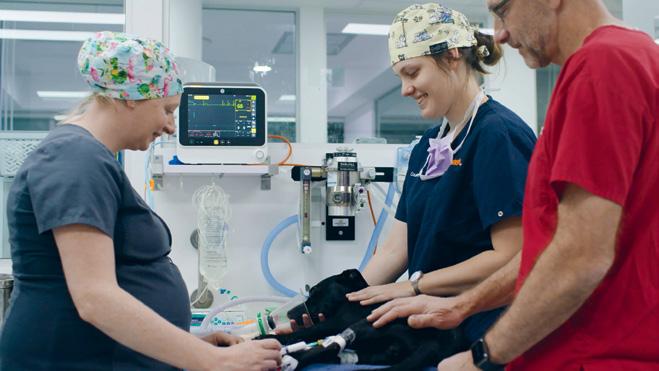
SASH Oncology Specialist and incoming SASH Western Sydney General Manager, Dr Sandra Nguyen, said it was exciting to be able to offer pet parents in the area new therapies to support their furry family members.
With three other well established facilities in North Ryde, the Central Coast and Adelaide, the Prospect site will add the SASH quality service and care to Western Sydney. This year to date, SASH has treated more than 32,000 cases across its various sites.
The state of the art facility features quality equipment, on par with that of a human hospital.
“With the new specialist areas such as oncology and dermatology and other therapies such as our sports medicine rehab centre, pet owners have access to a range of treatments at SASH that they may not even be aware of,” says Dr Nguyen.
“It’s all coming together; the MRI kit is going in and our specialists are really excited to start using the new equipment.”
The opening offers local veterinarians the opportunity to refer specialised cases to the new facility whose emergency and critical care unit is open 24 hours a day.
The new facility will be open for emergencies from 22 August and with the remainder of the services opening 29 August.
The Australian Government will provide $1.5 million to support Indonesia’s response to the recent outbreak of Foot and Mouth Disease (FMD).
The funding will provide at least one million FMD doses for Indonesia’s vaccination program, following a formal request for assistance from the Indonesian Government.
Indonesia’s vaccination program is focused on support for the small-holder farming sector, which makes up around 90 per cent of Indonesia’s cattle industry.
This support is in addition to Australia’s existing commitment of 435,000 Lumpy Skin Disease (LSD) vaccine doses that are currently being distributed to affected Indonesian provinces.
Minister for Agriculture, Fisheries and Forestry Murray Watt discussed Australia’s support with Indonesian Minister for Agriculture Syahrul Yasin Limpo in Jakarta.
Minister Watt also met with Indonesian National Disaster Management Authority head and Chief of the Indonesian Task Force for FMD, Lieutenant General Suharyanto.
“During my meeting with Lieutenant General Suharyanto we offered to share Australian expertise on emergency disease management and biosecurity.
“The Albanese Government is taking a two-pronged approach to preventing the incursion of FMD, first by strengthening biosecurity measures at the Australian border, and also by supporting efforts to curb the spread overseas,” he said.

The Australian Government has also committed an initial $500,000 to Meat and Livestock Australia, responsible for coordinating support from Australian industry for the Indonesian feedlot sector’s emergency response to these diseases.
Minister for Foreign Affairs, Senator the Hon Penny Wong, said that safeguarding the biosecurity of our region is a shared concern for Australia and Indonesia.
“The provision of one million vaccine doses to combat FMD disease underscores Australia’s commitment to supporting Indonesia’s response to the outbreak.”
The New Zealand Veterinary Association (NZVA) has announced that Dr Kate Hill has been appointed as its new President.
Qualified as a veterinarian from the University of Queensland, Dr Hill worked in the United States for seven years before moving to New Zealand in 2005 to work at Massey University. She has a PhD from Massey University and is a registered specialist in small animal internal medicine.
Dr Hill has been involved with the NZVA since 2006, serving on the Companion Animal Veterinarians (CAV) continuing education advisory committee, the CAV Committee (20072014), and the Companion Animal Health Foundation (now Healthy Pets) as a trustee (2012-2018). In 2016, she was awarded the CAV Annual Service Award.
She has been on the NZVA Board since 2018 and was elected president by her fellow Board members at the May 2022 meeting.

Dr Hill will take over from outgoing NZVA President, Dr Grant McCulloch, who over his three-year tenure, has helped NZVA to embed the changes from the Change project, has guided the association through a global pandemic, and a world veterinary labour shortage.
“It’s been a turbulent time in the world and in the veterinary space, so it’s more important than ever that we work together and talk over issues to get the solutions we need,” Dr Hill told Pet Industry News
“There is a huge shortage of veterinarians worldwide, so all veterinarians are overworked. Pet owners can help through understanding that veterinarians are trying their hardest.”
When it comes to offering up advice to aspiring veterinarians, Dr Hill said they should speak to as many people as they can from within the industry.
“Good communication and collaboration is key. Now is the time to work together in a collegial manner, with open two-way communication to continue to benefit all NZVA members and ultimately the entire veterinary profession. We are stronger together.”
Australians have smashed online shopping records over the past financial year, with pet products seeing the greatest growth at 38 per cent.

Australia Post delivered a record number of parcels to 9.3 million Aussie households during the financial year. This is just the second time ever that total households shopping online has surpassed nine million across the nation.
This was up from 9.1 million in the previous financial year, while online purchases grew almost 12 per cent.
The six months from July to December 2021 were particularly strong, and an average of 5.6 million households purchased something online each month in FY22, 1.5 million more than the average in FY20.
NSW residents received the highest number of parcels, with one in three purchases destined for the state, and grew more than 27 per cent year on year.
Also seeing significant growth in online purchases were the ACT (more than 27 per cent) and Western Australia (14 per cent).
Rose Yip, Australia Post Head of E-commerce Analytics, said the growth in online shopping had accelerated beyond expectations throughout the pandemic.
“We’ve seen more than 900 million parcels delivered in the last three years alone, which says so much about how quickly e-commerce has grown in a short amount of time.
“It’s now the norm for so many Australians, with more than five million households regularly shopping online every month, which is why we’ve not only increased our network capacity but we’re investing in more new facilities, technology and our fleet to set up a strong and sustainable network for the future.”
The most popular buys were pet products (up 38 per cent YOY), tools and garden items (29 per cent) and products from major and discount stores (32 per cent), while baby products and athleisure items also grew.
The Australian War Animal Memorial Organisation (AWAMO) is sending volunteers to Ukraine to help save animals impacted by war and is seeking donations to help with its efforts.
Animals in the Ukraine are being displaced as their owners flee the conflict zone into Poland at a staggering rate. Food and medications are hard to find even once they finally reach safety.

AWAMO has a shipping container filled with food, medication and winter supplies arriving shortly in Poland. The Polish Embassy in Australia has directed AWAMO to several Polish NGOs to partner with who are delivering aid across the Ukraine to animals impacted by the invasion of Russia into the Ukraine.
AWAMO was catapulted into action after receiving the distressing news that animals are starving and dying in zoos in Ukraine including Bear Sanctuaries in the southern region as a result of the war. AWAMO is desperate to get emergency aid to these locations.
In addition to the container landing in Poland, AWAMO will be putting feet on the ground sending two volunteer AWAMO personnel to purchase fodder, fresh food and other essentials and ensure this emergency aid is delivered to where it’s needed most.
Nigel Allsopp is the founder and president of AWAMO, he served in the military and has a distinguished career in the police service. He is one of the volunteers who will be boots on the ground in Ukraine and coordinating emergency aid and vital supplies.
AWAMO has been coordinating with the Ukrainian embassy here in Australia to meet with Ukrainian President Volodymyr Zelenskyy to present a war animal medal to a bomb-sniffing Jack Russell terrier named Patron and his handler.
AWAMO is asking Australians to donate money to help deliver these vital supplies to displaced pets, zoo animals, and animals in sanctuaries who are dying horrific deaths as a result of the war.
Made with colostrum, proven to boost the immune system and support intestinal health.

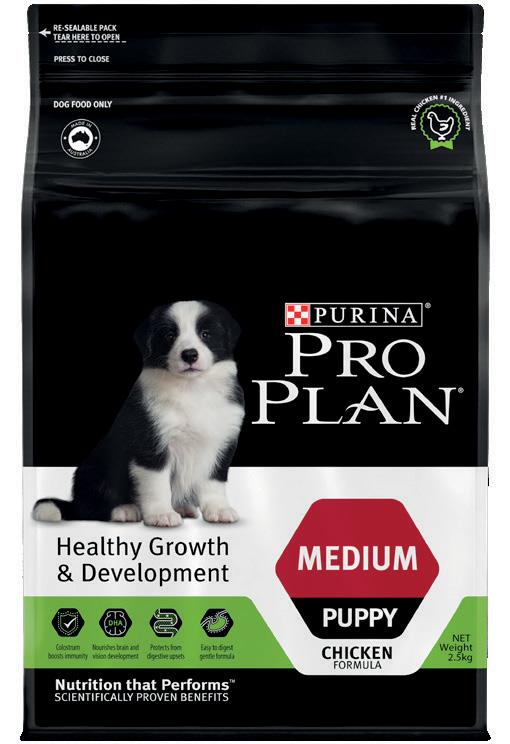






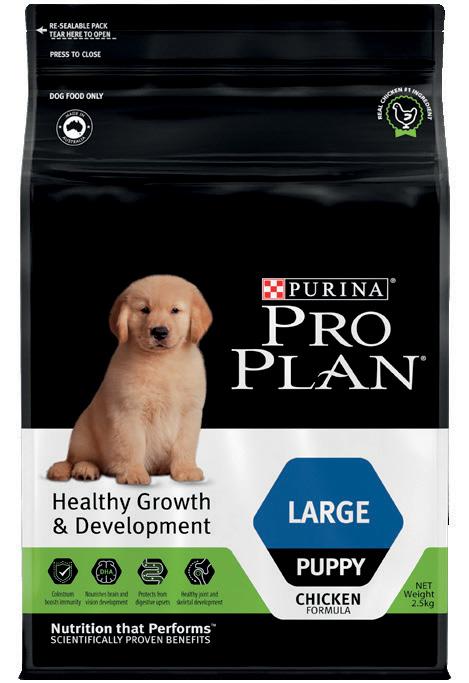




The first year of a pet’s life is crucial to their long-term health, which is why they need nutrition specifically formulated to nourish their developing bodies and minds. PRO PLAN Puppy & Kitten Dry Food combines all the essential nutrients that young pets need, including Colostrum – proven to support their immune system and protect them from common intestinal upsets.
The first year of a pet’s life is crucial to their long-term health, which is why they need nutrition specifically formulated to nourish their developing bodies and minds. PRO PLAN Puppy & Kitten Dry Food combines all the essential nutrients that young pets need, including Colostrum – proven to support their immune system and protect them from common intestinal upsets.


DHA, an omega-3 fatty acid, nourishes brain and vision development
Real meat is the #1 ingredient
Real meat is the #1 ingredient
No added artificial colours, flavours and preservatives
No added artificial colours, flavours and preservatives acid, nourishes brain and vision development
Available to range in Pet Specialty retail stores (including online), and Vet Clinics.

Available to range in Pet Specialty retail stores (including online), and Vet Clinics.

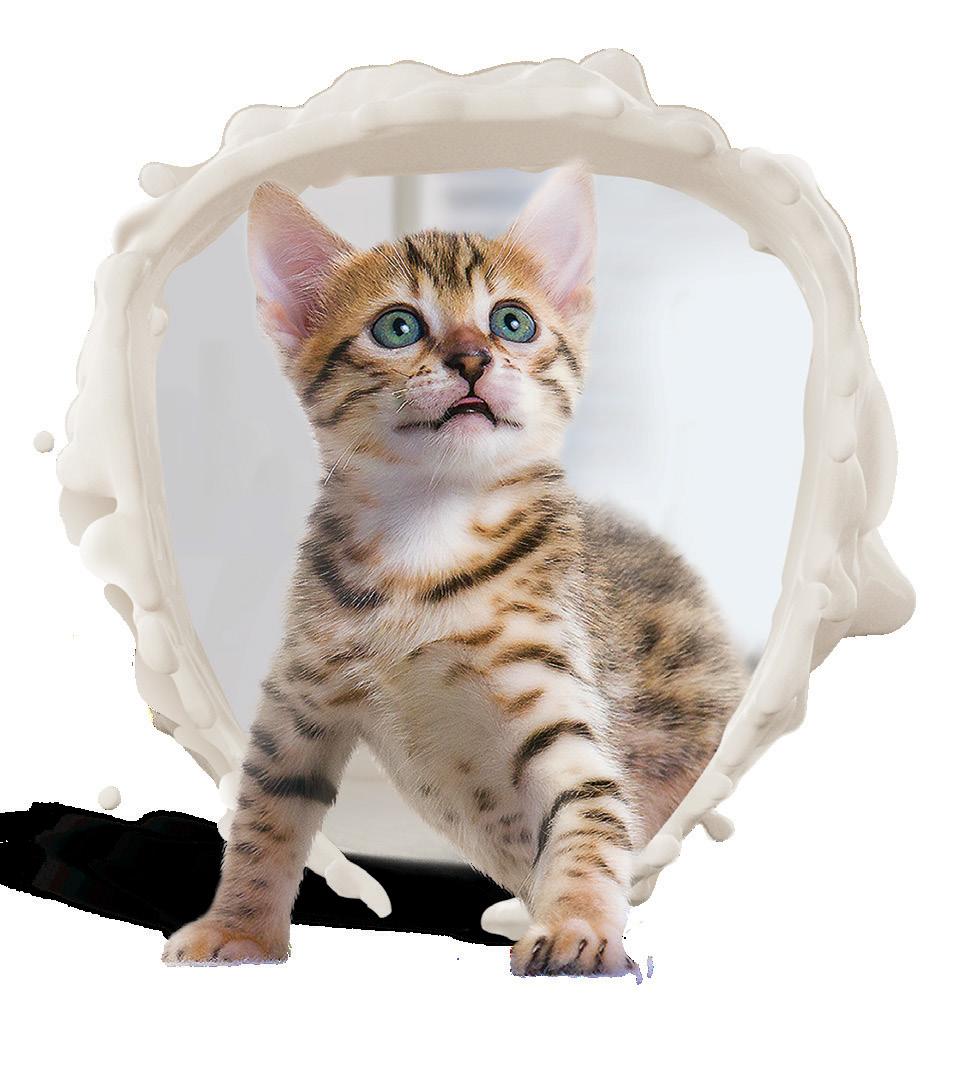



If you are interested in stocking PRO PLAN, contact our friendly PetCare Advice team for more details on 1800 738 238 or visit purina.com.au/contact-us
If you are interested in stocking PRO PLAN, contact our friendly PetCare Advice team for more details on 1800 738 238 or visit purina.com.au/contact-us















